Products
-
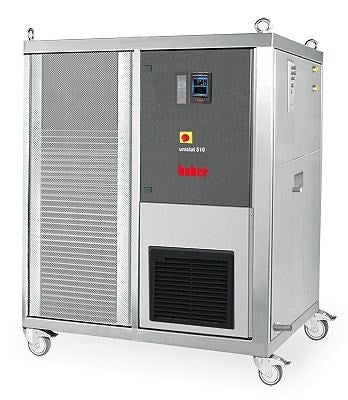

Huber Huber Unistat 510 with Pilot ONE 460V 3~ 60Hz
Huber Unistat 510 with Pilot ONE The Unistat range inspires with unique thermodynamic properties and a range of functions to meet the highest demands. Unistat technology guarantees precise, reproducible temperature control results, the shortest possible heating and cooling times and large temperature ranges without the need for fluid change. All Unistats are fitted with the innovative Pilot ONE controller with a 5.7“ touchscreen color display and easy menu navigation. All important parameters can be seen at a glance and temperature curves are displayed in graphic real time. Unistats are equipped with the most up-to-date pump technology for optimal heat transfer. The pump self regulates to ensure the best possible circulation and flow and delicate glass reactors are protected from breakage by the pumps soft start-up feature. Unistat technology impresses as a result of economic operation with reduced operating costs and efficient energy management. Because Unistats are hydraulically sealed, the service life of the temperature control fluid is dramatically increased by preventing oil loss through vapours and oxidation, further saving resources. Unistats are fitted with extensive safety equipment and are therefore suitable for unsupervised continuous operation. Relevant operating conditions are constantly monitored and the system is switched off if necessary or with the process safety feature the emergency cooling circuit is activated. The new multi-touch controller Pilot ONE offers a brilliant 5.7" touchscreen with graphic functions and a comfortable navigation menu. All important operating parameters and temperature values are neatly displayed on the touchscreen. Thanks to the new favorite menu, the one-click operation and the integrated technical glossary the operation is very easy, just like on a smartphone. Integrated USB and Ethernet ports allows connection to a PC or network, e.g. for remote control or data transmission. FEATURES: Precise and reproducible temperature control results Fastest heating and cooling rates Wide temperature ranges with no fluid change Pilot ONE controller with 5.7“ touchscreen and comfortable menu navigation Adaptive temperature control, self-optimizing Efficient circulation pump 2 x USB (Host and Device), Ethernet and RS232 interfaces Efficient operation saves working time and operating costs Proven functionality for the process industry E-grade "Professional" include Data Sheet 3 Year Warranty Extension Notes on Installation General information & temperature controller Temperature range -50...250 °C Temperature stability ±0.01 °C Temperature stability TAC, self-optimizing (True Adaptive Control) Display resolution 0.01 °C Alarm message optical, acoustical Controller Pilot ONE (E-grade "Professional") Safety class III / FL Protection class IP20 Dimensions (W x D x H) 560 x 754 x 1457 mm | 22.05 x 29.68 x 57.36 inches Weight 233 kg | 513.76 pounds Heating / cooling capacity Heating capacity 6 kW Cooling capacity 250 200 100 0 -20 -40 -50 C5,3 5,3 5,3 5,3 2,8 0,9 0,25 kW Cooling machine air-cooled Refrigerant (ASHRAE, GHS) R452A (A1, H280) (2,8 kg) Circulation pump Pressure pump max. 112 lpm ; 1.5 bar | 29.59 gpm ; 21.75 psi Pump connection M30x1,5 AG male Permissible viscosity 50 mm²/s Connections Pt100 connection Pt100 Analogue input via optional Com.G@te Analogue output via optional Com.G@te Digital interface RS232, Ethernet, USB Device, USB Host Operating data Permissible ambient temp. 5...40 °C Filling volume min. 4.1 Liters | 1.08 gal Volume of expansion 5.5 Liters | 1.45 gal Power supply 460V 3~ 60Hz Current max. 16 A
$82,566.21 - $83,260.04
-
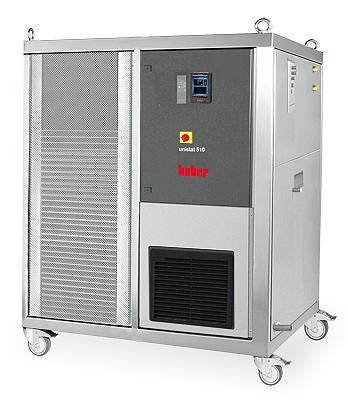

Huber Huber Unistat 510 with Pilot ONE 208V 3~ 60Hz
Huber Unistat 510 with Pilot ONE The Unistat range inspires with unique thermodynamic properties and a range of functions to meet the highest demands. Unistat technology guarantees precise, reproducible temperature control results, the shortest possible heating and cooling times and large temperature ranges without the need for fluid change. All Unistats are fitted with the innovative Pilot ONE controller with a 5.7“ touchscreen color display and easy menu navigation. All important parameters can be seen at a glance and temperature curves are displayed in graphic real time. Unistats are equipped with the most up-to-date pump technology for optimal heat transfer. The pump self regulates to ensure the best possible circulation and flow and delicate glass reactors are protected from breakage by the pumps soft start-up feature. Unistat technology impresses as a result of economic operation with reduced operating costs and efficient energy management. Because Unistats are hydraulically sealed, the service life of the temperature control fluid is dramatically increased by preventing oil loss through vapours and oxidation, further saving resources. Unistats are fitted with extensive safety equipment and are therefore suitable for unsupervised continuous operation. Relevant operating conditions are constantly monitored and the system is switched off if necessary or with the process safety feature the emergency cooling circuit is activated. The new multi-touch controller Pilot ONE offers a brilliant 5.7" touchscreen with graphic functions and a comfortable navigation menu. All important operating parameters and temperature values are neatly displayed on the touchscreen. Thanks to the new favorite menu, the one-click operation and the integrated technical glossary the operation is very easy, just like on a smartphone. Integrated USB and Ethernet ports allows connection to a PC or network, e.g. for remote control or data transmission. FEATURES: Precise and reproducible temperature control results Fastest heating and cooling rates Wide temperature ranges with no fluid change Pilot ONE controller with 5.7“ touchscreen and comfortable menu navigation Adaptive temperature control, self-optimising Efficient circulation pump 2 x USB (Host and Device), Ethernet and RS232 interfaces Efficient operation saves working time and operating costs Proven functionality for the process industry E-grade "Professional" include Data Sheet 3 Year Warranty Extension Note of Installation General information & temperature controller Temperature range -50...250 °C Temperature stability ±0.01 °C Temperature stability TAC, self-optimizing (True Adaptive Control) Display resolution 0.01 °C Alarm message optical, acoustical Controller Pilot ONE (E-grade "Professional") Safety class III / FL Protection class IP20 Dimensions (W x D x H) 560 x 754 x 1457 mm | 22.05 x 29.68 x 57.36 inches Weight 348 kg | 767.34 pounds Heating / cooling capacity Heating capacity 6 kW Cooling capacity 250 200 100 0 -20 -40 -50 C5,3 5,3 5,3 5,3 2,8 0,9 0,25 kW Cooling machine air-cooled Refrigerant (ASHRAE, GHS) R452A (A1, H280) (2,8 kg) Circulation pump Pressure pump max. 112 lpm ; 1.5 bar | 29.59 gpm ; 21.75 psi Pump connection M30x1,5 AG male Permissible viscosity 50 mm²/s Connections Pt100 connection Pt100 Analogue input via optional Com.G@te Analogue output via optional Com.G@te Digital interface RS232, Ethernet, USB Device, USB Host Operating data Permissible ambient temp. 5...40 °C Filling volume min. 4.1 Liters | 1.08 gal Volume of expansion 5.5 Liters | 1.45 gal Power supply 208V 3~ 60Hz Current max. 36 A
$100,744.65 - $101,438.49
-
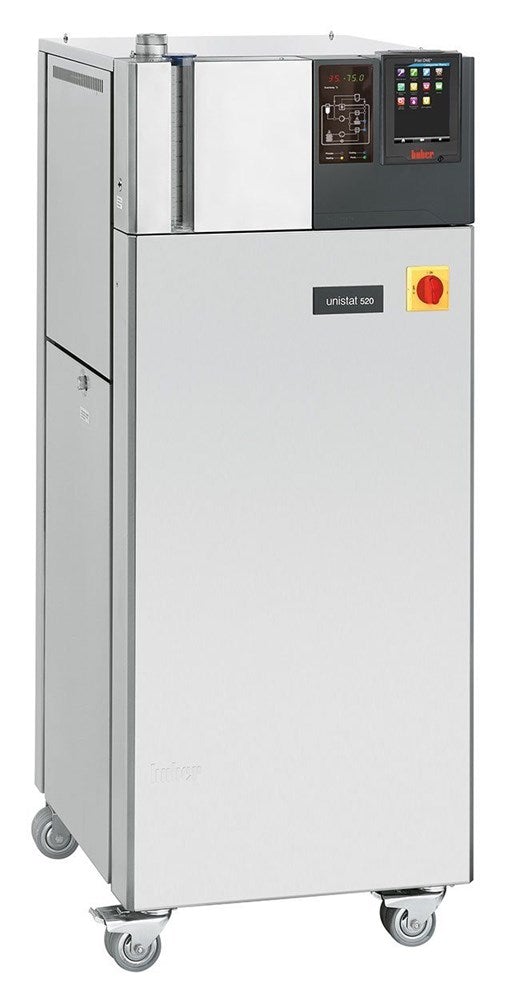

Huber Huber Unistat 520w with Pilot ONE
Huber Unistat 520w with Pilot ONE (Please Note: There is a shipping lead time of 2 - 3 weeks) he Unistat range inspires with unique thermodynamic properties and a range of functions to meet the highest demands. Unistat technology guarantees precise, reproducible temperature control results, the shortest possible heating and cooling times and large temperature ranges without the need for fluid change. All Unistats are fitted with the innovative Pilot ONE controller with a 5.7“ touchscreen colour display and easy menu navigation. All important parameters can be seen at a glance and temperature curves are displayed in graphic real time. Unistats are equipped with the most up-to-date pump technology for optimal heat transfer. The pump self regulates to ensure the best possible circulation and flow and delicate glass reactors are protected from breakage by the pumps soft start-up feature. Unistat technology impresses as a result of economic operation with reduced operating costs and efficient energy management. Because Unistats are hydraulically sealed, the service life of the temperature control fluid is dramatically increased by preventing oil loss through vapours and oxidation, further saving resources. Unistats are fitted with extensive safety equipment and are therefore suitable for unsupervised continuous operation. Relevant operating conditions are constantly monitored and the system is switched off if necessary or with the process safety feature the emergency cooling circuit is activated. The new multi-touch controller Pilot ONE offers a brilliant 5.7" touchscreen with graphic functions and a comfortable navigation menu. All important operating parameters and temperature values are neatly displayed on the touchscreen. Thanks to the new favourites menu, the one-click operation and the integrated technical glossary the operation is very easy, just like on a smartphone. Integrated USB and Ethernet ports allows connection to a PC or network, e.g. for remote control or data transmission. Data Sheet 3 Years Warranty Extension Operating manuals General information & temperature controller Temperature range -55...250 °C Temperature stability ±0.01 °C Temperature control TAC, self-optimizing (True Adaptive Control) Display resolution 0.01 °C Alarm message optical, acoustical Controller Pilot ONE (E-grade "professional") Safety class III / FL Protection class IP20 Dimensions (W x D x H) 540 x 604 x 1332 mm | 21.26 x 23.78 x 52.44 inches Weight 212 kg | 467.46 pounds Heating / cooling capacity Heating capacity 9 kW Cooling capacity 250 200 100 20 0 -20 -40 -50 °C 6 6 6 6 6 1,2 0,65 kW 250 200 Cooling machine water-cooled Refrigerant (ASHRAE, GHS) R452A (A1, H280) (1,44 kg) Circulation pump Pressure pump max. 79 lpm ; 1.5 bar | 20.87 gpm ; 21.75 psi Pump connection M30x1,5 AG male Permissible viscosity 50 mm²/s Connections Pt100 connection Pt100 Analogue input via optional Com.G@te Analogue output via optional Com.G@te Digital interface RS232, Ethernet, USB Device, USB Host Operating data Permissible ambient temp. 5...40 °C Noise level 61 dB(A) Filling volume min. 4.9 Liters | 1.29 gal Volume of expansion 16 Liters | 4.23 gal Cooling water connection G1/2 AG Cooling water differential pressure min. 1 bar | 14.5 psi Cooling water pressure max. 6 bar | 87 psi Power supply 460V 3~ 60Hz Current max. 13 A
$86,659.83 - $87,353.66
-
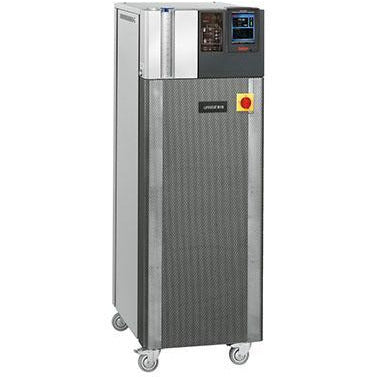

Huber HUBER Unistat 815 Dynamic Temperature Control / Circulation Thermostat
HUBER Unistat 815 Dynamic Temperature Control (Please Note: There is a 2 - 3 weeks lead time) Unistat Circulators are an ideal solution for fast and precise thermal control of externally connected applications. These systems offer rapid temperature change and a wide temperature range without having to change fluid. The new Pilot ONE controller features a navigation system with easily remembered icons and menus which are sorted by color to make routine work simpler. An amazing software guides you through your set up ensuring all the necessary settings are correct. Unistat 815 208V Data sheet Unistat 815 460V Data sheet 3 Year Warranty Extension General Information & Temperature Controller Unistat 815208V Unistat 815460V Temperature range -85...250 °C -85...250 Temperature stability ±0.01 °C ±0.01 Temperature control TAC, self-optimizing (True Adaptive Control) TAC, self-optimizing (True Adaptive Control) Alarm message optical, acoustical optical, acoustical Controller Pilot ONE (E-grade "Professional") Pilot ONE (E-grade "Professional") Safety class III / FL III / FL Protection class IP20 IP20 Dimensions (W x D x H) 18.11 x 23.78 x 65.55 inches 18.11 x 23.78 x 57.68 inches Weight 331 kg | 729.86 pounds 229 kg | 504.94 pounds Heating / Cooling Capacity Heating capacity 2 kW 2,6 kW Cooling machine air-cooled air-cooled Refrigerant 1. stage R452A (A1, H280) (1,8 kg) R452A (A1, H280) (1,8 kg) Refrigerant 2. stage R23 (A1, H280) (0,39 kg) R23 (A1, H280) (0,39 kg) Circulation Pump Pressure pump max. 40 lpm ; 0.9 bar | 10.57 gpm ; 13.05 psi 40 lpm ; 0.9 bar | 10.57 gpm ; 13.05 psi Pump connection M30x1,5 AG male M30x1,5 AG male Permissible viscosity 50 mm²/s 50 mm²/s Connections Pt100 connection Pt100 Pt100 Digital interface RS232, Ethernet, USB Device, USB Host RS232, Ethernet, USB Device, USB Host Analogue input via optional Com.G@te via optional Com.G@te Analogue output via optional Com.G@te via optional Com.G@te Operating Data Old Sku 1014.0054.01 1014.0055.01 Permissible ambient temp. 5 to 40 °C 5 to 40 °C Noise Level 64 dB(A) 64 dB(A) Filling volume min. 3.8 Liters / 1 gal 3.8 Liters / 1 gal Volume of expansion 3.3 Liters / 0.87 gal 3.3 Liters / 0.87 gal Power supply 208V 3~ 60Hz 460V 3~ 60Hz Current max 21,5 A 11 A
$79,443.96 - $90,475.91
-
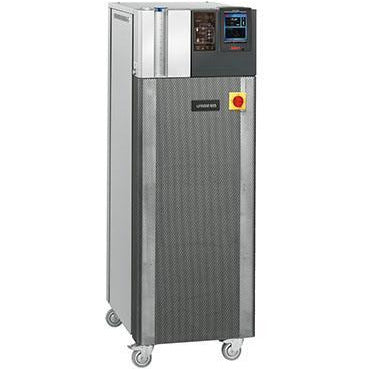

Huber HUBER Unistat 825 Dynamic Temperature Control / Circulation Thermostat
HUBER Unistat 825 Dynamic Temperature Control (Please Note: There is a 2 weeks Shipping lead time) Unistat Circulators are an ideal solution for fast and precise thermal control of externally connected applications. These systems offer rapid temperature change and a wide temperature range without having to change fluid. The new Pilot ONE controller features a navigation system with easily remembered icons and menus which are sorted by color to make routine work simpler. An amazing software guides you through your set up ensuring all the necessary settings are correct. General Information & Temperature Controller Unistat 825208V Unistat 825460V Temperature range -85...250 °C -85...250 Temperature stability ±0.01 °C ±0.01 Temperature control TAC, self-optimizing (True Adaptive Control) TAC, self-optimizing (True Adaptive Control) Display resolution 0.01 °C 0.01 °C Alarm message optical, acoustical optical, acoustical Controller Pilot ONE (E-grade "Professional") Pilot ONE (E-grade "Professional") Safety class III / FL III / FL Protection class IP20 IP20 Dimensions (W x D x H) 18.11 x 23.78 x 65.55 inches 18.11 x 23.78 x 57.68 inches Weight 696.78 Lb 487.3 Lb Heating / Cooling Capacity Heating capacity 3 kW 4 kW Cooling machine air-cooled air-cooled Refrigerant 1. stage R507 (1,8 kg) R507 (1,8 kg) Refrigerant 2. stage R23 R23 Circulation Pump Pressure pump max. 10.57 gpm ; 13.05 psi 10.57 gpm ; 13.05 psi Pump connection M30x1,5 AG male M30x1,5 AG male Permissible viscosity 50 mm²/s 50 mm²/s Connections Pt100 connection Pt100 Pt100 Digital interface RS232, Ethernet, USB Device, USB Host RS232, Ethernet, USB Device, USB Host Operating Data Permissible ambient temp. 5 to 40 °C 5 to 40 °C Noise level 64 dB(A) 64 dB(A) Filling volume min. 2.9 Liters / 0.77 gal 2.9 Liters / 0.77 gal Volume of expansion 3.6 Liters / 0.95 gal 3.6 Liters / 0.95 gal Power supply 208V 3~ 60Hz 460V 3~ 60Hz Current max 20 A 14,5 A
$114,690.71 - $1,262,777.33
-


Huber HUBER Unistat 905 Dynamic Temperature Control / Circulation Thermostat
HUBER Unistat 905 Dynamic Temperature Control (Please Note: There is 8 week shipping lead time) Disclaimer: This item is Non-Refundable once ordered. Unistat Circulators are an ideal solution for fast and precise thermal control of externally connected applications. These systems offer rapid temperature change and a wide temperature range without having to change fluid. The new Pilot ONE controller features a navigation system with easily remembered icons and menus which are sorted by color to make routine work simpler. An amazing software guides you through your set up ensuring all the necessary settings are correct. Unistat 905 208V Data sheet Unistat 905 460V Data sheet General Information & Temperature Controller Unistat 905 208V Unistat 905 460V Temperature range -90 to 250 °C -90 to 250 °C Temperature stability ±0.01 °C ±0.01 Temperature control TAC, self-optimizing (True Adaptive Control) TAC, self-optimizing (True Adaptive Control) Display resolution 0.01 °C 0.01 °C Alarm message optical, acoustical optical, acoustical Controller Pilot ONE (E-grade "Professional") Pilot ONE (E-grade "Professional") Safety class III / FL III / FL Protection class IP20 IP20 Dimensions (W x D x H) 540 x 654 x 1738 mm | 21.26 x 25.75 x 68.43 inches 540 x 654 x 1500 mm | 21.26 x 25.75 x 59.06 inches Weight 396 kg | 873.18 pounds 275 kg | 606.38 pounds Heating / Cooling Capacity Heating capacity 6 kW 6 kW Cooling machine air-cooled air-cooled Refrigerant 1. stage R452A (A1, H280) (2,5 kg) R452A (A1, H280) (2,5 kg) Refrigerant 2. stage R23 (A1, H280) (0,75 kg) R23 Circulation Pump Pressure pump max. 48 lpm ; 0.9 bar | 12.68 gpm ; 13.05 psi 10.57 gpm ; 13.05 psi Pump connection M30x1,5 AG male M30x1,5 AG male Permissible viscosity 50 mm²/s 50 mm²/s Connections Pt100 connection Pt100 Pt100 Analogue input via optional Com.G@te via optional Com.G@te Analogue output via optional Com.G@te via optional Com.G@te Digital interface RS232, Ethernet, USB Device, USB Host RS232, Ethernet, USB Device, USB Host Operating Data Old sku 1035.0013.01 1035.0014.01 Permissible ambient temp. 5...35 °C 5...35 °C Filling volume min. 3.2 Liters | 0.85 gal 3.2 Liters | 0.85 gal Volume of expansion 5.3 Liters | 1.4 gal 5.3 Liters | 1.4 gal Power supply 208V 3~ 60Hz 460V 3~ 60Hz Current max 40 A 23,5 A
$147,092.74 - $164,438.59
-
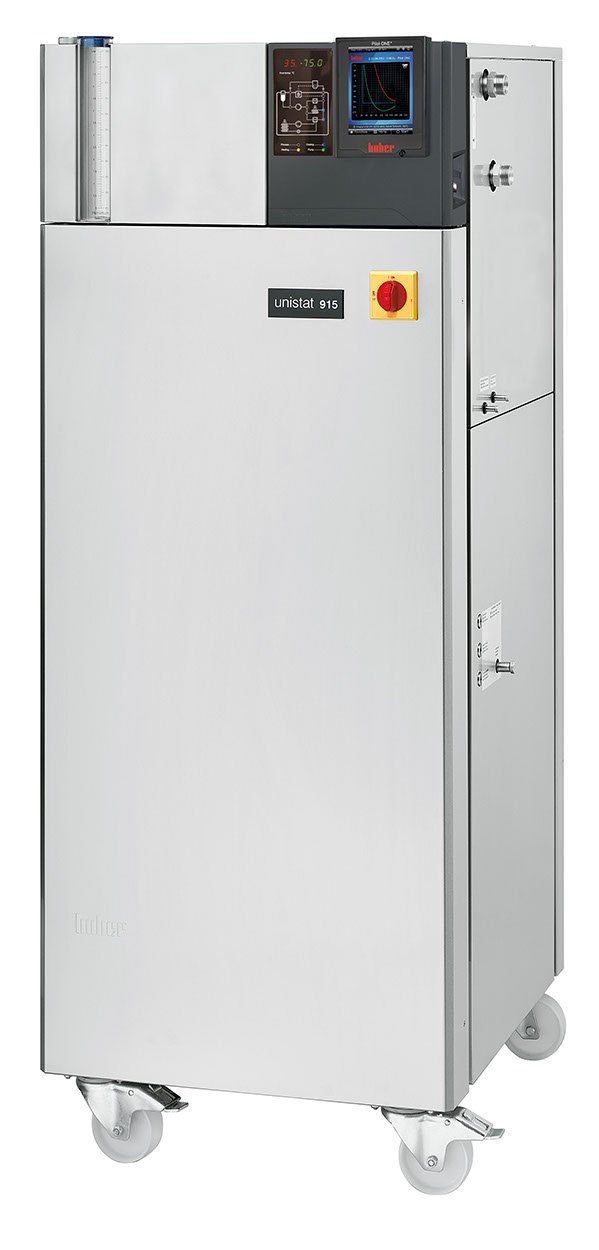

Huber Huber Unistat 915w with Pilot ONE
Huber Unistat 915w with Pilot ONE (Please Note: There is a 2 - 3 weeks lead time) Unistat Circulators are an ideal solution for fast and precise thermal control of externally connected applications. These systems offer rapid temperature change and a wide temperature range without having to change fluid. The new Pilot ONE controller features a navigation system with easily remembered icons and menus which are sorted by color to make routine work simpler. An amazing software guides you through your set up ensuring all the necessary settings are correct. Precise and reproducible temperature control results Fastest heating and cooling rate Wide temperature ranges with no fluid change Pilot ONE controller with 5.7“ touchscreen and comfortable menu navigation Adaptive temperature control, self-optimising Efficient circulation pump Data communication via LAN, internet, USB, RS232 and RS485 Efficient operation saves working time and operating costs Proven functionality for the process industry E-grade "Professional" included Download Data Sheet Click Here for 3 Year Warranty Online Registration Download Operating Manual General information & Temperature Controller Temperature range -90...250 °C Temperature stability ±0.02 °C ±0.01 °C Temperature control TAC, self-optimizing (True Adaptive Control) Display resolution 0.01 °C Alarm message optical, acoustical Controller Pilot ONE (E-grade "Professional") Safety class III / FL Protection class IP20 Dimensions (W x D x H) 630 x 704 x 1565 mm | 24.8 x 27.72 x 61.61 inches Weight 364 kg | 802.62 pounds Heating / Cooling Capacity Heating capacity 6 kW Cooling capacity 250 200 100 0 -20 -40 -60 -80 -90 °C 6,5 7,5 9 11 11 11 8,2 4,2 1,3 0,6 kW Cooling machine water-cooled Refrigerant 1. stage R507 (A1, H280) (2,9 kg) Refrigerant 2. stage R23 (A1, H280) (1,23 kg) Circulation Pump Pressure pump max. 110 lpm ; 1.5 bar | 29.06 gpm ; 21.75 psi Pump Connection M30x1,5 AG male Permissible viscosity 50 mm²/s Connections Pt100 connection Pt100 Analogue input via optional Com.G@te Analogue output via optional Com.G@te Digital interface RS232, Ethernet, USB Device, USB Host Operating Data Old sku 1055.0011.01 Permissible ambient temp. 5...40 °C Noise level 64 dB(A) Filling volume min. 3.9 Liters | 1.03 gal Volume of expansion 6.5 Liters | 1.72 gal Cooling water connection G3/4 AG Cooling water differential pressure min. 1 bar | 14.5 psi Cooling water pressure max. 6 bar | 87 psi Power supply 460V 3~ 60Hz Current max. 29 A
$190,526.73 - $191,220.57
-
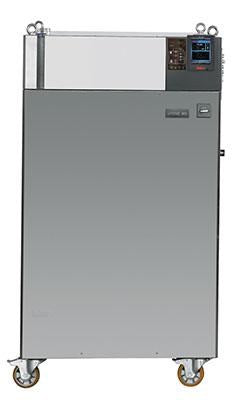

Huber Huber Unistat 925w with Pilot ONE
Huber Unistat 925w with Pilot ONE The Unistat range inspires with unique thermodynamic properties and a range of functions to meet the highest demands. Unistat technology guarantees precise, reproducible temperature control results, the shortest possible heating and cooling times and large temperature ranges without the need for fluid change. All Unistats are fitted with the innovative Pilot ONE controller with a 5.7“ touchscreen colour display and easy menu navigation. All important parameters can be seen at a glance and temperature curves are displayed in graphic real time. Unistats are equipped with the most up-to-date pump technology for optimal heat transfer. The pump self regulates to ensure the best possible circulation and flow and delicate glass reactors are protected from breakage by the pumps soft start-up feature. Unistat technology impresses as a result of economic operation with reduced operating costs and efficient energy management. Because Unistats are hydraulically sealed, the service life of the temperature control fluid is dramatically increased by preventing oil loss through vapours and oxidation, further saving resources. Unistats are fitted with extensive safety equipment and are therefore suitable for unsupervised continuous operation. Relevant operating conditions are constantly monitored and the system is switched off if necessary or with the process safety feature the emergency cooling circuit is activated. The new multi-touch controller Pilot ONE offers a brilliant 5.7" touchscreen with graphic functions and a comfortable navigation menu. All important operating parameters and temperature values are neatly displayed on the touchscreen. Thanks to the new favourites menu, the one-click operation and the integrated technical glossary the operation is very easy, just like on a smartphone. Integrated USB and Ethernet ports allows connection to a PC or network, e.g. for remote control or data transmission. Additional Info: Precise and reproducible temperature control results Fastest heating and cooling rates Wide temperature ranges with no fluid change Pilot ONE controller with 5.7“ touchscreen and comfortable menu navigation Adaptive temperature control, self-optimising Efficient circulation pump Data communication via LAN, internet, USB, RS232 and RS485 Efficient operation saves working time and operating costs Proven functionality for the process industry E-grade "Professional" included Data sheet 3 Year Warranty Operatoring Manuals General information & temperature controller Power Supply 460V 3~ 60Hz Temperature range -90...200 °C Temperature stability ±0.01 °C Temperature control TAC, self-optimizing (True Adaptive Control) Display resolution 0.01 °C Alarm message optical, acoustical Controller Pilot ONE (E-grade "Professional") Safety class III / FL Protection class IP20 Dimensions (W x D x H) 950 x 1205 x 1650 mm | 37.4 x 47.44 x 64.96 inches Weight 980 kg | 2160.9 pounds Heating / cooling capacity Heating capacity 16 kW Cooling capacity 200 100 20 0 -20 -40 -60 -80 -9016 16 16 16 16 15 13,5 13,5 1,8 kW Cooling machine water-cooled Refrigerant 1. stage (ASHRAE, GHS) R452A (A1, H280) (5 kg) Refrigerant 2. stage (ASHRAE, GHS) R23 (A1, H280) (2,2 kg) Circulation pump Pressure pump max. 168 lpm ; 2.5 bar | 44.39 gpm ; 36.25 psi Pump connection M38x1,5 AG male Permissible viscosity 50 mm²/s Connections Pt100 connection Pt100 Analogue input via optional Com.G@te Analogue output via optional Com.G@te Digital interface RS232, Ethernet, USB Device, USB Host Operating data Permissible ambient temp. 5...40 °C Noise level - Filling volume min. 12 Liters | 3.17 gal Volume of expansion 29 Liters | 7.66 gal Cooling water connection G3/4 AG Cooling water differential pressure min. 1 bar | 14.5 psi Cooling water pressure max. 6 bar | 87 psi Power supply 460V 3~ 60Hz Current max. 46 A
$342,198.78 - $342,892.61
-
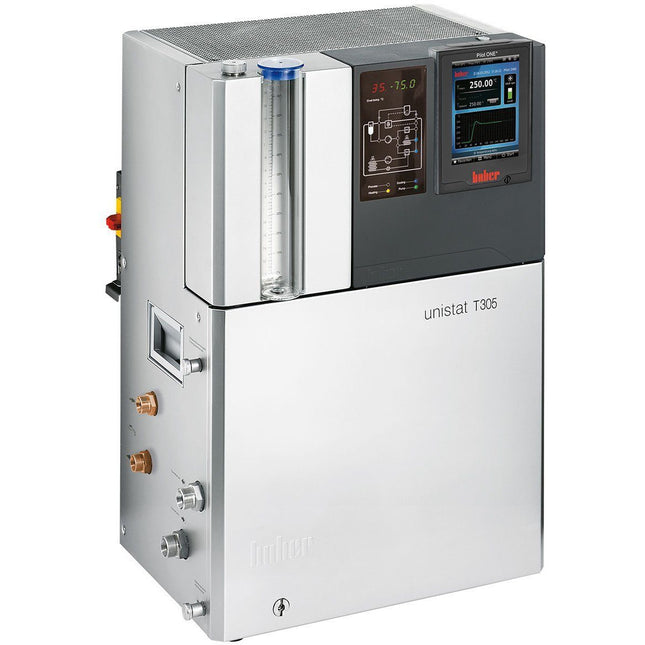

Huber HUBER Unistat T305 with Pilot ONE
HUBER Unistat T305 with Pilot ONE (Please Note: There is a 2 - 3 weeks lead time) The Unistat range inspires with unique thermodynamic properties and a range of functions to meet the highest demands. Unistat technology guarantees precise, reproducible temperature control results, the shortest possible heating and cooling times and large temperature ranges without the need for fluid change. All Unistats are fitted with the innovative Because Unistats are hydraulically sealed, the service life of the temperature control fluid is dramatically increased by preventing oil loss through vapours and oxidation, further saving resources. Unistats are fitted with extensive safety equipment and are therefore suitable for unsupervised continuous operation. Relevant operating conditions are constantly monitored and the system is switched off if necessary or with the process safety feature the emergency cooling circuit is activated. Data sheet 3 Year Warranty Extension General Information & Temperature Controller Temperature range 65...300 °C Temperature stability ±0,02 °C Temperature control TAC, self-optimizing (True Adaptive Control) Controller Pilot ONE (E-grade "Basic") Safety class III / FL Protection class IP20 Dimensions (W x D x H) 425 x 250 x 631 mm | 16.73 x 9.84 x 24.84 inches Weight 37 kg | 81.59 pounds Heating / Cooling Capacity Heating capacity 4,8 kW Circulation Pump Pressure pump max. 45 lpm ; 0.9 bar | 11.89 gpm ; 13.05 psi Pump connection M24x1,5 AG male Permissible viscosity 50 mm²/s Connections Pt100 connection Pt100 Analogue input via optional Com.G@te Analogue output via optional Com.G@te Digital interface RS232, Ethernet, USB Device, USB Host Operating Data Old sku 1003.0022.01 Permissible ambient temp. 5 to 40 °C Filling volume min. 1.45 Liters | 0.38 gal Volume of expansion 2.8 Liters | 0.74 gal Power supply 208V 3~ 60Hz Current max. 15 A Fusing 15,5 A
$32,540.80 - $33,234.63
-
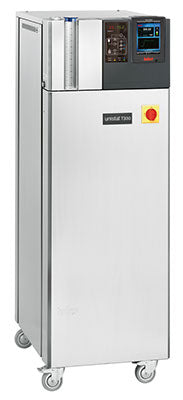

Huber Huber Unistat T330 with Pilot ONE
Huber Unistat T330 with Pilot ONE The Unistat range inspires with unique thermodynamic properties and a range of functions to meet the highest demands. Unistat technology guarantees precise, reproducible temperature control results, the shortest possible heating and cooling times and large temperature ranges without the need for fluid change. All Unistats are fitted with the innovative Pilot ONE controller with a 5.7“ touchscreen colour display and easy menu navigation. All important parameters can be seen at a glance and temperature curves are displayed in graphic real time. Unistats are equipped with the most up-to-date pump technology for optimal heat transfer. The pump self regulates to ensure the best possible circulation and flow and delicate glass reactors are protected from breakage by the pumps soft start-up feature. Unistat technology impresses as a result of economic operation with reduced operating costs and efficient energy management. Because Unistats are hydraulically sealed, the service life of the temperature control fluid is dramatically increased by preventing oil loss through vapours and oxidation, further saving resources. Unistats are fitted with extensive safety equipment and are therefore suitable for unsupervised continuous operation. Relevant operating conditions are constantly monitored and the system is switched off if necessary or with the process safety feature the emergency cooling circuit is activated. General information & temperature controller Temperature range 65...300 °C Temperature stability ±0,01 °C Temperature control TAC, self-optimizing (True Adaptive Control) Display resolution 0,01 °C Alarm message optical, acoustical Controller Pilot ONE (E-grade "Professional") Safety class III / FL Protection class IP20 Dimensions (W x D x H) 540 x 678 x 1174 mm Weight -- kg Heating / cooling capacity Heating capacity 21 - 24 kW Circulation pump Pressure pump max. 96 l/min ; 3,5 bar Pump connection M30x1,5 AG male Permissible viscosity 50 mm²/s Pump speed adjustable Yes Connections Pt100 connection Pt100 Analogue input via optional Com.G@te Analogue output via optional Com.G@te Digital interface RS232, Ethernet, USB Device, USB Host Operating data Permissible ambient temp. 5...40 °C Volume of expansion 24 Litres Power supply 380-460V 3~ 50/60Hz
$87,908.73
-


Huber Huber Unistat T402 with Pilot ONE
Huber Unistat T402 with Pilot ONE The Unistat range inspires with unique thermodynamic properties and a range of functions to meet the highest demands. Unistat technology guarantees precise, reproducible temperature control results, the shortest possible heating and cooling times and large temperature ranges without the need for fluid change. All Unistats are fitted with the innovative Pilot ONE controller with a 5.7“ touchscreen color display and easy menu navigation. All important parameters can be seen at a glance and temperature curves are displayed in graphic real time. Unistats are equipped with the most up-to-date pump technology for optimal heat transfer. The pump self regulates to ensure the best possible circulation and flow and delicate glass reactors are protected from breakage by the pumps soft start-up feature. Unistat technology impresses as a result of economic operation with reduced operating costs and efficient energy management. Because Unistats are hydraulically sealed, the service life of the temperature control fluid is dramatically increased by preventing oil loss through vapors and oxidation, further saving resources. Unistats are fitted with extensive safety equipment and are therefore suitable for unsupervised continuous operation. Relevant operating conditions are constantly monitored and the system is switched off if necessary or with the process safety feature the emergency cooling circuit is activated. Precise and reproducible temperature control results Wide temperature ranges with no fluid change Pilot ONE controller with 5.7“ touchscreen and comfortable menu navigation Adaptive temperature control, self-optimizing Efficient circulation pump 2 x USB (Host and Device), Ethernet and RS232 interfaces Efficient operation saves working time and operating costs Proven functionality for the process industry E-grade "Professional" included General Information & Temperature Controller Temperature range 65...300 °C Temperature stability ±0.05 °C Temperature control TAC, self-optimizing (True Adaptive Control) Display resolution 0.01 °C Alarm message optical, acoustical Controller Pilot ONE (E-grade "Basic") Safety class III / FL Protection class IP20 Dimensions (W x D x H) 505 x 400 x 765 mm | 19.88 x 15.75 x 30.12 inches Weight 54 kg | 119.07 pounds Heating / Cooling Capacity Heating capacity 4,8 kW Circulation Pump Pressure pump max. 45 lpm ; 0.9 bar | 11.89 gpm ; 13.05 psi Pump connection M24x1,5 AG male Permissible viscosity 50 mm²/s Connections Pt100 connection Pt100 Analogue input via optional Com.G@te Analogue output via optional Com.G@te Digital interface RS232, Ethernet, USB Device, USB Host Operating Data Old sku 1038.0004.01 Permissible ambient temp. 5 to 40 °C Filling volume min. 1.45 Liters | 0.38 gal Volume of expansion 2.8 Liters | 0.74 gal Power supply 208V 3~ 60Hz Cooling water Connection G1/2 AG
$67,301.87 - $67,995.70
-


Huber Huber Unistat Tango with Pilot ONE
Huber Unistat Tango with Pilot ONE (Please Note: There is 2-3 weeks Shipping lead time) Unistats are predestined for applications in process and chemical engineering, such as temperature control of reactors, autoclaves, Miniplant/Pilot systems, reactor blocks and calorimeters. Unistat temperature control systems with their unique thermodynamics provide highly accurate and reproducible results, guaranteeing the shortest heating and cooling times and a wide temperature range without fluid change. Environmentally and economically Unistats stand out, offering natural refrigerants and an efficient energy management system for reduced operating costs. . Precise and reproducible temperature control results Fastest heating and cooling rates Wide temperature ranges with no fluid change Pilot ONE controller with 5.7“ touchscreen and comfortable menu navigation Adaptive temperature control, self-optimising Efficient circulation pump 2 x USB (Host and Device), Ethernet and RS232 interfaces Efficient operation saves working time and operating costs Proven functionality for the process industry E-grade "Professional" included Download Data sheet Unistat tango Download Data Sheet Unistat tango w Download Data Sheet Unistat tango wl Operating Manual Click here 3 year Warranty Register General Information & Temperature Controller Unistat Tango Unistat Tango w Unistat Tango wl Temperature range -45...250 °C -45...250 °C -45...250 °C Temperature stability ±0.01 °C ±0.01 ±0.01 °C Temperature control TAC, self-optimizing (True Adaptive Control) TAC, self-optimizing (True Adaptive Control) TAC, self-optimizing (True Adaptive Control) Display resolution 0.01 °C 0.01 °C 0.01 °C Alarm message optical, acoustical optical, acoustical optical, acoustical Controller Pilot ONE (E-grade "Professional") Pilot ONE (E-grade "Professional") Pilot ONE (E-grade "Professional") Safety class III / FL III / FL III / FL Protection class IP20 IP20 IP20 Dimensions (W x D x H) 16.77 x 12.87 x 24.84 inches 16.77 x 12.87 x 24.84 inches 16.77 x 12.87 x 24.84 inches Weight 141.12 pounds 119.07 pounds 132.3 pounds Heating / Cooling Capacity Heating capacity 3 kW 3 kW 3 kW Cooling capacity 250 200 100 0 -20 -40 °C0,7 0,7 0,7 0,7 0,4 0,06 kW 250 200 100 0 -20 -40 °C0,7 0,7 0,7 0,7 0,4 0,06 kW 250 200 100 0 -20 -40 °C0,7 0,7 0,7 0,7 0,4 0,06 kW Cooling machine air-cooled water-cooled air- and water-cooled Refrigerant R1270 (0,15 kg) R1270 (0,09 kg R1270 (0,15 kg) Circulation Pump Pressure pump max. 55 lpm ; 0.9 bar | 14.53 gpm ; 13.05 psi 55 lpm ; 0.9 bar | 14.53 gpm ; 130.5 psi 55 lpm ; 0.9 bar | 14.53 gpm ; 130.5 psi Pump connection M24x1,5 AG male M24x1,5 AG male M24x1,5 AG male Permissible viscosity 50 mm²/s 50 mm²/s Connections Pt100 connection Pt100 Pt100 Pt100 Analogue input via optional Com.G@te via optional Com.G@te via optional Com.G@te Analogue outpu via optional Com.G@te via optional Com.G@te via optional Com.G@te Digital interface RS232, Ethernet, USB Device, USB Host RS232, Ethernet, USB Device, USB Host RS232, Ethernet, USB Device, USB Host Operating Data Permissible ambient temp. 5 to 40 °C 5 to 40 °C 5 to 40 °C Noise level 62 dB(A) - 62 dB(A) Filling volume min. 1.5 Liters | 0.4 gal 1.5 Liters | 0.4 gal 1.5 Liters | 0.4 gal Volume of expansion 2.8 Liters | 0.74 gal 2.8 Liters | 0.74 gal 2.8 Liters | 0.74 gal Cooling water connection - G1/2 AG G1/2 AG Cooling water consumption - 24 l/h 30 l/h Cooling water differential pressure min. - 0,5 bar | 72.5 psi 0,5 bar | 72.5 psi Cooling water pressure max. - 6 bar | 87 psi 6 bar | 87 psi Power supply 208V 2~ 60Hz 208V 2~ 60Hz 208V 2~ 60Hz Current max 18 A 16,5 A 17,5 A Fusing 20 A 2x20 A 2x20 A
$40,103.59 - $43,642.14
-


Hydrochloric Acid 37% ACS Reagent Grade (HCL)
Hydrochloric Acid 37% ACS Reagent Grade HCL pH: 1.1 Hydrochloric acid, solution is a colorless watery liquid with a sharp, irritating odor. Consists of hydrogen chloride, a gas, dissolved in water. Sinks and mixes with water. HCL vapors are heavier than air. It is classified as a Strong Acid and is used in many types of laboratory preparations. Cruelty-free: Our Hydrochloric Acid is not tested on animals. Chemical Formula: HCl Molecular Weight: 36.46 CAS Registry Number: 7647-01-0 Appearance Colorless, transparent liquid, fumes in air if concentrated Odor: Pungent characteristic Density 0.81 g/cm3 Boiling Point: 61C @ 36% Concentration GHS Pictograms: GHS Signal Word: Danger GHS Hazard Statements: H290, H314, H335 GHS Precautionary Statements P210, P233, P240, P305+P351+P338, P403+P23 P260, P280, P303+P361+P353, P305+P351+P338 UN Identification Number: 1789 Proper Shipping Name: Hydrochloric acid solution Transport Hazard Class: 8 Packing Group: II DOT Placard: What Is Hydrochloric Acid? Hydrochloric acid (HCl) is a strong, highly corrosive acid that is widely used in various industrial, commercial, and laboratory applications. It is a solution of hydrogen chloride gas dissolved in water, forming a clear, colorless liquid with a sharp, pungent odor. Chemically, hydrochloric acid is composed of hydrogen (H) and chlorine (Cl) atoms, with a chemical formula of HCl. In aqueous solution, hydrochloric acid dissociates into hydrogen ions (H⁺) and chloride ions (Cl⁻), making it a strong acid. How Is Hydrochloric Acid Produced? Hydrochloric acid (HCl) is typically produced on an industrial scale through the chemical reaction between hydrogen gas (H2) and chlorine gas (Cl2). This reaction is exothermic and requires the presence of a suitable catalyst to proceed efficiently. The primary method for producing hydrochloric acid involves the following steps: Preparation of Hydrogen: Hydrogen gas (H2) is produced through various methods, such as steam reforming of natural gas (methane), electrolysis of water, or as a byproduct of certain chemical processes. Steam reforming is the most common method for large-scale hydrogen production, where methane is reacted with steam in the presence of a nickel-based catalyst to produce hydrogen gas and carbon monoxide: CH4 + H2O → CO + 3H2 The produced hydrogen gas is then purified to remove impurities before use in the hydrochloric acid production process. Preparation of Chlorine: Chlorine gas (Cl2) is typically produced by the electrolysis of sodium chloride (table salt) solution, known as the chlor-alkali process. In this process, an electric current is passed through a brine solution (sodium chloride dissolved in water), resulting in the decomposition of water and the formation of chlorine gas at the anode: 2Cl⁻ → Cl2 + 2e⁻ The chlorine gas is then purified and dried to remove any water vapor before use in the hydrochloric acid production process. Hydrogen-Chlorine Reaction: Once hydrogen and chlorine gases are prepared, they are combined and reacted in a controlled manner. The reaction typically occurs in a reactor vessel equipped with a suitable catalyst, such as platinum or rhodium, to facilitate the reaction: H2 + Cl2 → 2HCl This reaction produces hydrochloric acid gas (HCl), which is then cooled and condensed to form a liquid solution of hydrochloric acid. Dissolution in Water: The hydrochloric acid gas is dissolved in water to produce a concentrated solution of hydrochloric acid. This solution can be further diluted to the desired concentration for various industrial, commercial, or laboratory applications. Overall, the production of hydrochloric acid involves the controlled reaction of hydrogen and chlorine gases in the presence of a catalyst, followed by the dissolution of the resulting hydrochloric acid gas in water. The process is typically carried out in specialized chemical plants equipped with the necessary infrastructure and safety measures to handle corrosive and hazardous materials. What Is Hydrochloric Acid Used for? Hydrochloric acid (HCl) is a versatile and widely used chemical with numerous industrial, commercial, and laboratory applications. Some common uses of hydrochloric acid include: Chemical Manufacturing: Hydrochloric acid is used in the production of a wide range of chemicals, including chlorine, vinyl chloride (used to make PVC), and various pharmaceuticals, dyes, and pigments. Steel Pickling: Hydrochloric acid is commonly used for pickling or cleaning steel surfaces to remove rust, scale, and other impurities before further processing, such as galvanizing or coating. pH Control: Hydrochloric acid is used as a pH adjuster or neutralizer in various industrial processes, wastewater treatment, and swimming pool maintenance. Food Processing: Hydrochloric acid is used in the food industry for various purposes, including adjusting acidity, flavor enhancement, and food preservation (in accordance with regulatory guidelines). Laboratory Applications: Hydrochloric acid is commonly used in laboratories for chemical analysis, titrations, and as a reagent in various chemical reactions. Household Cleaning Products: Dilute hydrochloric acid solutions are used in household cleaning products, such as toilet bowl cleaners and descaling agents. Oil and Gas Production: Hydrochloric acid is used in the oil and gas industry for various applications, including well acidization to enhance the productivity of oil and gas wells. Water Treatment: Hydrochloric acid is used in water treatment processes to control pH, remove mineral scale deposits, and neutralize alkaline substances. Textile and Leather Processing: Hydrochloric acid is used in textile and leather processing industries for desizing, bleaching, and pH adjustment. Metal Cleaning and Etching: Hydrochloric acid is used for cleaning and etching metals, such as aluminum, copper, and brass, in various manufacturing processes. Chemical Synthesis: Hydrochloric acid is used as a reactant or catalyst in various chemical synthesis processes, including the production of pharmaceuticals, plastics, and synthetic rubber. These are just a few examples of the diverse range of applications for hydrochloric acid. Its versatility, corrosive properties, and ability to adjust pH make it an essential chemical in many industries and processes. However, it's important to handle hydrochloric acid with care due to its corrosive nature and potential health hazards. Proper safety precautions, such as wearing protective equipment and following appropriate handling and storage procedures, should be observed when working with hydrochloric acid. What Are The Hazards of Hydrochloric Acid? Hydrochloric acid (HCl) is a highly corrosive and hazardous chemical that can pose several risks to human health, safety, and the environment. Some of the main hazards associated with hydrochloric acid include: Corrosive Properties: Hydrochloric acid is highly corrosive to skin, eyes, respiratory tract, and mucous membranes. Contact with concentrated hydrochloric acid can cause severe chemical burns, irritation, and tissue damage. Inhalation of hydrochloric acid vapors or mists can also cause irritation and damage to the respiratory system. Acute Toxicity: Exposure to high concentrations of hydrochloric acid vapor or mist can cause acute toxicity, leading to symptoms such as coughing, difficulty breathing, chest pain, and throat irritation. Severe exposure may result in pulmonary edema (fluid buildup in the lungs) and respiratory distress. Environmental Hazards: Spills or releases of hydrochloric acid can have adverse effects on the environment, including contamination of soil, water bodies, and aquatic ecosystems. Hydrochloric acid can be corrosive to metals and may cause damage to infrastructure and equipment if not properly contained and managed. Reactivity: Hydrochloric acid is reactive with a wide range of substances, including metals, alkalis, and organic materials. It can release hazardous gases (such as hydrogen gas) when reacting with certain metals, posing fire and explosion hazards in confined spaces. Storage and Handling Risks: Hydrochloric acid must be stored and handled with care due to its corrosive and reactive nature. Improper storage, handling, or mixing with incompatible substances can lead to accidents, spills, and exposure incidents. Health Effects: Prolonged or repeated exposure to hydrochloric acid vapor or mist may cause chronic respiratory effects, such as bronchitis, asthma, or chronic obstructive pulmonary disease (COPD). Individuals with pre-existing respiratory conditions or sensitivities may be more susceptible to the effects of hydrochloric acid exposure. Skin and Eye Damage: Contact with hydrochloric acid can cause severe chemical burns and damage to the skin and eyes. Eye contact may result in irritation, redness, and blurred vision, while skin contact may cause pain, redness, and blistering. Ingestion Hazards: Ingestion of hydrochloric acid can cause severe burns to the mouth, throat, esophagus, and stomach, leading to tissue damage, perforation, and internal bleeding. Ingestion of even small amounts of concentrated hydrochloric acid can be life-threatening and requires immediate medical attention. Overall, the hazards associated with hydrochloric acid underscore the importance of proper handling, storage, and use of this chemical in industrial, commercial, and laboratory settings. Employers and workers should be trained on the safe handling procedures, use of personal protective equipment, and emergency response protocols to minimize the risks associated with hydrochloric acid exposure. Additionally, regulatory guidelines and safety standards should be followed to ensure compliance and protect human health and the environment. Hydrochloric Acid Safety Data Sheet (SDS)
$22.20 - $1,595.82
-


Hydrogen Peroxide 35% Food Grade
35% Food Grade Hydrogen Peroxide This is the second highest concentration of hydrogen peroxide we offer just under our 50% Food Grade Hydrogen Peroxide. Our food-grade peroxide is clear, colorless, and free of any stabilizers or additives. Peroxide is one of the most effective oxidizers and may be applied to food directly to food products. Our peroxide is certified FCC (Food Chemical Codex). It has been tested and verified for its quality and purity. 35% Food Grade Hydrogen Peroxide Certificate of Analysis 35% Food Grade Hydrogen Peroxide Safety Data Sheet Our food-grade hydrogen peroxide is 12x strength, when diluted you can make a remarkably large volume of 3% hydrogen peroxide that can be used for a wide variety of applications. 1 Quart 35% Makes 4.2 Gallons of 3% 1 Gallon 35% Makes 11.5 Gallons of 3% 5 Gallon 35% Makes 57.8 Gallons of 3% 55 Gallon 35% Makes 634 Gallons of 3% Some applications include... Elevating Plant Growth: Diluted hydrogen peroxide supports healthy roots and elevated oxygen availability in the soil. Excellent Cleaner for Food Prep Environments: Hydrogen peroxide is a disinfectant, that kills viruses and various forms of bacteria. Bleaching: Diluted hydrogen peroxide is a mild bleaching agent that can be used to clean stains. Cleansing Fresh Produce: Diluted hydrogen peroxide can be used to clean fruits and vegetables. Mold and Mildew Removal: Hydrogen peroxides strong oxidative qualities breakdown mold and mildew with ease. How to Dilute 35% Hydrogen Peroxide to 3% Hydrogen Peroxide: 35% food-grade hydrogen peroxide Deionized distilled water A clean, empty Gallon bottle for the final 3% hydrogen peroxide solution Measuring cup Funnel Safety goggles Rubber gloves Apron or old clothes Steps to perform dilution: Wear safety goggles, rubber gloves, an apron or old clothing to protect yourself from spills and splashes. Choose a well-ventilated space. Mix 1 part 35% hydrogen peroxide with 11 parts distilled water. Example: Mix 1 cup hydrogen peroxide, with 11 cups of distilled water. To be exact, this will make a slightly less than 3% solution of hydrogen peroxide – 2.92%. What Is Hydrogen Peroxide? Hydrogen peroxide (H2O2) is a chemical compound composed of two hydrogen atoms and two oxygen atoms. It is a clear, colorless liquid with a slightly more viscous consistency than water. Hydrogen peroxide is commonly used for its powerful oxidizing properties and has a wide range of applications in various industries and household settings. Chemical Formula: H2O2 Molecular Weight: 34.015 g/mol CAS Registry Number: 7722-84-1 Appearance Colorless Liquid Odor: None Density 1.11 g/cm3 Boiling Point: 106 °C (223 °F) Solubility in water: Completely Soluble GHS Pictograms: GHS Signal Word: Danger GHS Hazard Statements: H272, H302, H318, H335 GHS Precautionary Statements P210, P220, P260, P261, P264, P270, P271, P280, P283, P301+P317, P301+P330+P331, P302+P361+P354, P304+P340, P305+P354+P338, P306+P360, P316, P317, P321, P330, P363, P370+P378, P371+P380+P375, P405, P420, and P501 UN Identification Number: 2014 Proper Shipping Name: 35% Hydrogen Peroxide, Aqueous Solution Transport Hazard Class: 5.1, 8 Packing Group: II DOT Placard: What Is Hydrogen Peroxide Used For? Hydrogen peroxide (H2O2) is used for a wide range of purposes in various industries and household settings due to its versatile properties. Some common uses of hydrogen peroxide include: Disinfectant and Antiseptic: Hydrogen peroxide is a common disinfectant and antiseptic agent. It is used to clean wounds, cuts, and minor injuries to prevent infection. In lower concentrations (typically 3%), it can be safely applied to the skin. Hair Bleaching and Dyeing: Many hair bleaching and hair dyeing products contain hydrogen peroxide as it can help break down the natural pigments in hair, lightening its color. Teeth Whitening: Hydrogen peroxide is used in some teeth whitening products and dental treatments to remove stains and discoloration from teeth. Cleaning Agent: It is used as a cleaning agent for surfaces, fabrics, and contact lenses due to its ability to break down and remove organic stains and deposits. Water Treatment: In water treatment processes, hydrogen peroxide can be used to remove contaminants, oxidize organic matter, and disinfect water supplies. Rocket Propellant: In the aerospace industry, highly concentrated hydrogen peroxide (usually around 90% purity) is used as a rocket propellant. Chemical Synthesis: Hydrogen peroxide is used in the synthesis of various chemicals and pharmaceuticals. Environmental Applications: It can be employed for soil and groundwater remediation, helping to break down pollutants and contaminants. Food Industry: In the food industry, hydrogen peroxide can be used for cleaning and disinfection of equipment and packaging materials. Cosmetics: It is used in some cosmetic and personal care products, such as hair dyes, hair bleaches, and skin creams. Textiles: Hydrogen peroxide is used in the textile industry to bleach fabrics and remove stains. Paper and Pulp Industry: It is used for bleaching paper pulp and improving the quality of paper products. Agriculture: In agriculture, hydrogen peroxide can be used as an oxygen source in soil, promoting plant growth. Medical and Laboratory Use: It is utilized for cleaning and sterilizing medical equipment and laboratory instruments. First Aid: Hydrogen peroxide is a household item for treating minor cuts and scrapes. The specific application and concentration of hydrogen peroxide used can vary depending on the intended purpose. Higher concentrations are typically used in industrial and chemical applications, while lower concentrations are common in household and personal care products. It's important to handle hydrogen peroxide with care, follow safety guidelines, and use the appropriate concentration for a given task. How Is Hydrogen Peroxide Produced? Hydrogen peroxide (H2O2) is typically produced through one of two main methods: the anthraquinone process and the direct synthesis process. Both processes involve the reaction of hydrogen and oxygen in the presence of a catalyst to form hydrogen peroxide. Here's an overview of these two methods: Anthraquinone Process: This is the most common method for commercial hydrogen peroxide production. It involves a series of chemical reactions that use anthraquinone derivatives as catalysts. The process typically consists of the following steps: Hydrogenation: Anthraquinone derivatives are hydrogenated with hydrogen gas (H2) to form hydroquinone derivatives. Autoxidation: The hydroquinone derivatives react with oxygen (O2) to form anthraquinone derivatives again, while producing hydrogen peroxide in the process. Extraction: The hydrogen peroxide is then extracted from the reaction mixture. Oxidation of Anthraquinone: The anthraquinone derivatives are oxidized back to their original form for reuse in the process. Direct Synthesis Process: In this method, hydrogen and oxygen are directly combined to produce hydrogen peroxide using a catalyst. The reaction typically occurs in a gas-phase reactor, and the process is often referred to as the "direct synthesis" or "hydrogenation-oxygenation" process. Common catalysts used in this process include palladium or platinum on a support material. While these are the main methods for hydrogen peroxide production, there are other less common methods as well. The choice of production method depends on factors such as the desired concentration of hydrogen peroxide, production scale, and cost considerations. It's worth noting that hydrogen peroxide is a sensitive compound and can decompose over time, especially when exposed to heat, light, or contaminants. Therefore, it requires careful handling and storage to maintain its stability and effectiveness. Does Hydrogen Peroxide Expire? Hydrogen peroxide can degrade over time and may lose its effectiveness, so it can be said to have a shelf life rather than a strict expiration date. The shelf life of hydrogen peroxide depends on several factors, including its concentration, exposure to light, temperature, and how well it's stored. Here are some general guidelines: Concentration: Higher concentrations of hydrogen peroxide (e.g., 30% or 35%) tend to be more stable and have a longer shelf life compared to lower concentrations (e.g., 3% or 6%). Exposure to Light: Hydrogen peroxide is light-sensitive, and exposure to ultraviolet (UV) light can accelerate its decomposition. It is typically sold in brown or opaque containers to protect it from light. Temperature: Storage at higher temperatures can also speed up the decomposition of hydrogen peroxide. It should be stored at a cool, dry place away from heat sources. Contaminants: Contaminants or impurities can catalyze the decomposition of hydrogen peroxide. It's essential to keep the container tightly sealed and free from any potential contaminants. Age: Hydrogen peroxide degrades slowly over time, even when stored correctly. The rate of degradation is higher for lower concentrations. To maximize the shelf life and potency of hydrogen peroxide, follow these recommendations: Store it in its original, tightly sealed container. Keep it in a cool, dark place away from direct sunlight and heat sources. Check the expiration date on the container, if available. If you're unsure about the potency of an old bottle of hydrogen peroxide, consider testing it on a small, non-critical area before using it for medical or cleaning purposes. It's important to note that even if hydrogen peroxide has degraded, it may still be useful for some applications, such as cleaning and disinfecting surfaces. However, for medical or first-aid use, it's best to use hydrogen peroxide that is within its recommended shelf life to ensure its effectiveness. Is Hydrogen Peroxide Safe As Mouthwash? Hydrogen peroxide can be used as a mouthwash, but it should be used with caution and in a diluted form. Here are some important considerations: Dilution: Never use undiluted hydrogen peroxide as a mouthwash. It's too concentrated at its full strength and can cause irritation, burning, and tissue damage. Instead, dilute it with water. A common recommendation is to use a 3% hydrogen peroxide solution, which is typically sold in drugstores. Frequency: Do not use hydrogen peroxide as a mouthwash too frequently. Using it daily or excessively can lead to oral issues, including irritation and disruption of the natural balance of oral bacteria. Duration: When using hydrogen peroxide as a mouthwash, swish it around your mouth for a brief period, typically about 30 seconds, and then spit it out. Do not swallow it. Rinse Thoroughly: After using hydrogen peroxide as a mouthwash, rinse your mouth thoroughly with water to remove any residual hydrogen peroxide. Avoid Ingestion: Do not swallow hydrogen peroxide, even when diluted. Swallowing hydrogen peroxide can lead to stomach upset and other health issues. Consultation: Before using hydrogen peroxide as a mouthwash, it's a good idea to consult with your dentist or oral healthcare provider. They can provide guidance on its safe and appropriate use based on your specific oral health needs. Hydrogen peroxide can help kill harmful bacteria in the mouth and may be used as a short-term remedy for issues like canker sores or minor gum irritations. However, it is not a substitute for regular oral hygiene practices such as brushing, flossing, and using a fluoride-based mouthwash. If you experience any adverse reactions, such as severe irritation, burning, or pain, discontinue use immediately and consult a healthcare professional. It's important to use hydrogen peroxide as a mouthwash cautiously and in accordance with recommended guidelines to avoid potential side effects or harm to oral tissues. What Are The Hazards Of Hydrogen Peroxide? Hydrogen peroxide, while commonly used for various purposes, can pose certain hazards if mishandled or used improperly. Here are some of the potential hazards associated with hydrogen peroxide: Irritation and Burns: Hydrogen peroxide is a strong oxidizing agent and can cause skin and eye irritation upon contact. In higher concentrations or with prolonged exposure, it can lead to chemical burns. Ingestion: Ingesting concentrated hydrogen peroxide can be harmful and even life-threatening. It can cause gastrointestinal irritation, stomach pain, vomiting, and, in severe cases, internal burns or damage. Inhalation: Inhalation of hydrogen peroxide vapors can irritate the respiratory tract, leading to coughing, shortness of breath, and throat irritation. Explosive Hazards: Concentrated hydrogen peroxide solutions can be sensitive to shock, heat, or contamination with organic materials. This can lead to the potential for explosions or fires if mishandled. Skin Sensitization: Prolonged or repeated contact with hydrogen peroxide can lead to skin sensitization, where the skin becomes more sensitive or allergic to the chemical. Environmental Impact: Hydrogen peroxide can be harmful to aquatic life and the environment if not properly disposed of. It should not be released into natural waterways. hydrogen peroxide, consider the following precautions: Dilution: When using hydrogen peroxide, dilute it to the appropriate concentration for the intended purpose. Most household hydrogen peroxide solutions are 3%, while higher concentrations are used for industrial or medical applications. Protective Equipment: When handling concentrated hydrogen peroxide, wear appropriate personal protective equipment, including gloves and safety goggles. Ventilation: Use hydrogen peroxide in well-ventilated areas to minimize inhalation risks. First Aid: In case of skin or eye contact, rinse immediately with plenty of water. If ingested, seek medical attention. Storage: Store hydrogen peroxide in a cool, dark place away from flammable materials and heat sources. Dispose Properly: Dispose of hydrogen peroxide in accordance with local regulations. Do not pour it down drains or release it into the environment. Always follow the safety guidelines and instructions provided on the product label or by the manufacturer. If you have specific concerns or questions about handling hydrogen peroxide for a particular application, it's advisable to consult with a safety professional or chemical expert for guidance. How Can I Use Hydrogen Peroxide Safely? Using hydrogen peroxide safely involves taking appropriate precautions to minimize the risk of accidents or harm. Here are some guidelines for safe handling and use of hydrogen peroxide: Read the Label: Always read and follow the instructions and safety precautions provided on the hydrogen peroxide product label. Different concentrations may have different recommended uses and safety guidelines. Personal Protective Equipment (PPE): Wear appropriate personal protective equipment, including safety goggles or a face shield to protect your eyes. Use gloves made of materials that are compatible with hydrogen peroxide, such as nitrile or latex gloves. Ventilation: Use hydrogen peroxide in a well-ventilated area to minimize exposure to vapors. If you're using it in a confined space, consider using a fume hood or working near an open window or door. Concentration: Ensure that you are using the correct concentration of hydrogen peroxide for your specific application. Most household hydrogen peroxide solutions are typically 3%, but higher concentrations are available for industrial or medical use. Dilution: When diluting concentrated hydrogen peroxide, always add the hydrogen peroxide to water, not the other way around. This helps prevent splattering and potential reactions. Avoid Contaminants: Keep hydrogen peroxide away from organic materials (e.g., paper, cloth) and flammable substances, as it can react with them and potentially cause fires or explosions. Avoid Mixing: Do not mix hydrogen peroxide with other chemicals unless you are following a specific recipe or procedure that requires it. Mixing hydrogen peroxide with certain substances can be dangerous. First Aid: In case of skin contact, immediately rinse the affected area with plenty of water. If hydrogen peroxide comes into contact with your eyes, flush them with water for at least 15 minutes and seek medical attention if irritation persists. If ingested, do not induce vomiting. Seek medical attention immediately. Storage: Store hydrogen peroxide in a cool, dark place, away from direct sunlight and heat sources. Keep the container tightly closed when not in use. Disposal: Dispose of hydrogen peroxide in accordance with local regulations. Do not pour it down drains or release it into the environment. Emergency Response: Have access to an emergency eyewash station and safety shower if you are working with concentrated hydrogen peroxide. Keep a spill kit and appropriate cleanup materials on hand in case of accidents. Training: Ensure that individuals handling hydrogen peroxide are trained in its safe use and understand the potential hazards. If you are unsure about how to use hydrogen peroxide safely for a specific application, consider seeking guidance from a safety professional or chemical expert. Always exercise caution and pr
$30.53 - $4,024.24
-


Hydrogen Peroxide 35% Technical Grade, NSF Certified, H2O2
35% Technical Grade Hydrogen Peroxide Our Technical-grade 35% peroxide tests at ~34.8%. It's our second highest concentrated peroxide next to our 50% Tech Grade Peroxide. Our Technical Grade hydrogen peroxide is formulated with a special stabilizer package that replaces transition metals stabilizers typically found in hydrogen peroxide solutions. Our Peroxide is NSF® Certified. NSF-certified means a product was independently verified for safety, sanitation, and quality by NSF. NSF certification is recognized by health departments, government agencies, and industry associations. *Certified under ANSI/NSF Standard 60 Drinking Water Additives-Health Effects. Dosage levels shall be in accordance with NSF requirements. 55 Gallon Drum weights 500lbs, 330 Gallon Tote weighs 3000lbs. 35% Food Grade Hydrogen Peroxide Certificate of Analysis 35% Food Grade Hydrogen Peroxide Safety Data Sheet Our 34% hydrogen peroxide when diluted you can make a remarkably large volume of 3% hydrogen peroxide that can be used for a wide variety of applications. 1 Quart 35% Makes 4.2 Gallons of 3% 1 Gallon 35% Makes 11.5 Gallons of 3% 5 Gallon 35% Makes 57.8 Gallons of 3% 55 Gallon 35% Makes 634 Gallons of 3% Some applications include... Elevating Plant Growth: Diluted hydrogen peroxide supports healthy roots and elevated oxygen availability in the soil. Excellent Cleaner for Food Prep Environments: Hydrogen peroxide is a disinfectant, that kills viruses and various forms of bacteria. Bleaching: Diluted hydrogen peroxide is a mild bleaching agent that can be used to clean stains. Cleansing Fresh Produce: Diluted hydrogen peroxide can be used to clean fruits and vegetables. Mold and Mildew Removal: Hydrogen peroxides strong oxidative qualities breakdown mold and mildew with ease. How to Dilute 35% Hydrogen Peroxide to 3% Hydrogen Peroxide: 35% hydrogen peroxide Deionized distilled water A clean, empty Gallon bottle for the final 3% hydrogen peroxide solution Measuring cup Funnel Safety goggles Rubber gloves Apron or old clothes Steps to perform dilution: Wear safety goggles, rubber gloves, an apron or old clothing to protect yourself from spills and splashes. Choose a well-ventilated space. Mix 1 part 34.83% hydrogen peroxide with 10 parts distilled water. Example: Mix 1 cup hydrogen peroxide, with 10 cups of distilled water. To be exact, this will make slightly more than 3% solution of hydrogen peroxide – 3.46%. What Is Hydrogen Peroxide? Hydrogen peroxide (H2O2) is a chemical compound composed of two hydrogen atoms and two oxygen atoms. It is a clear, colorless liquid with a slightly more viscous consistency than water. Hydrogen peroxide is commonly used for its powerful oxidizing properties and has a wide range of applications in various industries and household settings. Chemical Formula: H2O2 Molecular Weight: 34.015 g/mol CAS Registry Number: 7722-84-1 Appearance Colorless Liquid Odor: None Density 1.11 g/cm3 Boiling Point: 106 °C (223 °F) Solubility in water: Completely Soluble GHS Pictograms: GHS Signal Word: Danger GHS Hazard Statements: H272, H302, H318, H335 GHS Precautionary Statements P210, P220, P260, P261, P264, P270, P271, P280, P283, P301+P317, P301+P330+P331, P302+P361+P354, P304+P340, P305+P354+P338, P306+P360, P316, P317, P321, P330, P363, P370+P378, P371+P380+P375, P405, P420, and P501 UN Identification Number: 2014 Proper Shipping Name: 35% Hydrogen Peroxide, Aqueous Solution Transport Hazard Class: 5.1, 8 Packing Group: II DOT Placard: What Is Hydrogen Peroxide Used For? Hydrogen peroxide (H2O2) is used for a wide range of purposes in various industries and household settings due to its versatile properties. Some common uses of hydrogen peroxide include: Disinfectant and Antiseptic: Hydrogen peroxide is a common disinfectant and antiseptic agent. It is used to clean wounds, cuts, and minor injuries to prevent infection. In lower concentrations (typically 3%), it can be safely applied to the skin. Hair Bleaching and Dyeing: Many hair bleaching and hair dyeing products contain hydrogen peroxide as it can help break down the natural pigments in hair, lightening its color. Teeth Whitening: Hydrogen peroxide is used in some teeth whitening products and dental treatments to remove stains and discoloration from teeth. Cleaning Agent: It is used as a cleaning agent for surfaces, fabrics, and contact lenses due to its ability to break down and remove organic stains and deposits. Water Treatment: In water treatment processes, hydrogen peroxide can be used to remove contaminants, oxidize organic matter, and disinfect water supplies. Rocket Propellant: In the aerospace industry, highly concentrated hydrogen peroxide (usually around 90% purity) is used as a rocket propellant. Chemical Synthesis: Hydrogen peroxide is used in the synthesis of various chemicals and pharmaceuticals. Environmental Applications: It can be employed for soil and groundwater remediation, helping to break down pollutants and contaminants. Food Industry: In the food industry, hydrogen peroxide can be used for cleaning and disinfection of equipment and packaging materials. Cosmetics: It is used in some cosmetic and personal care products, such as hair dyes, hair bleaches, and skin creams. Textiles: Hydrogen peroxide is used in the textile industry to bleach fabrics and remove stains. Paper and Pulp Industry: It is used for bleaching paper pulp and improving the quality of paper products. Agriculture: In agriculture, hydrogen peroxide can be used as an oxygen source in soil, promoting plant growth. Medical and Laboratory Use: It is utilized for cleaning and sterilizing medical equipment and laboratory instruments. First Aid: Hydrogen peroxide is a household item for treating minor cuts and scrapes. The specific application and concentration of hydrogen peroxide used can vary depending on the intended purpose. Higher concentrations are typically used in industrial and chemical applications, while lower concentrations are common in household and personal care products. It's important to handle hydrogen peroxide with care, follow safety guidelines, and use the appropriate concentration for a given task. How Is Hydrogen Peroxide Produced? Hydrogen peroxide (H2O2) is typically produced through one of two main methods: the anthraquinone process and the direct synthesis process. Both processes involve the reaction of hydrogen and oxygen in the presence of a catalyst to form hydrogen peroxide. Here's an overview of these two methods: Anthraquinone Process: This is the most common method for commercial hydrogen peroxide production. It involves a series of chemical reactions that use anthraquinone derivatives as catalysts. The process typically consists of the following steps: Hydrogenation: Anthraquinone derivatives are hydrogenated with hydrogen gas (H2) to form hydroquinone derivatives. Autoxidation: The hydroquinone derivatives react with oxygen (O2) to form anthraquinone derivatives again, while producing hydrogen peroxide in the process. Extraction: The hydrogen peroxide is then extracted from the reaction mixture. Oxidation of Anthraquinone: The anthraquinone derivatives are oxidized back to their original form for reuse in the process. Direct Synthesis Process: In this method, hydrogen and oxygen are directly combined to produce hydrogen peroxide using a catalyst. The reaction typically occurs in a gas-phase reactor, and the process is often referred to as the "direct synthesis" or "hydrogenation-oxygenation" process. Common catalysts used in this process include palladium or platinum on a support material. While these are the main methods for hydrogen peroxide production, there are other less common methods as well. The choice of production method depends on factors such as the desired concentration of hydrogen peroxide, production scale, and cost considerations. It's worth noting that hydrogen peroxide is a sensitive compound and can decompose over time, especially when exposed to heat, light, or contaminants. Therefore, it requires careful handling and storage to maintain its stability and effectiveness. Does Hydrogen Peroxide Expire? Hydrogen peroxide can degrade over time and may lose its effectiveness, so it can be said to have a shelf life rather than a strict expiration date. The shelf life of hydrogen peroxide depends on several factors, including its concentration, exposure to light, temperature, and how well it's stored. Here are some general guidelines: Concentration: Higher concentrations of hydrogen peroxide (e.g., 30% or 35%) tend to be more stable and have a longer shelf life compared to lower concentrations (e.g., 3% or 6%). Exposure to Light: Hydrogen peroxide is light-sensitive, and exposure to ultraviolet (UV) light can accelerate its decomposition. It is typically sold in brown or opaque containers to protect it from light. Temperature: Storage at higher temperatures can also speed up the decomposition of hydrogen peroxide. It should be stored at a cool, dry place away from heat sources. Contaminants: Contaminants or impurities can catalyze the decomposition of hydrogen peroxide. It's essential to keep the container tightly sealed and free from any potential contaminants. Age: Hydrogen peroxide degrades slowly over time, even when stored correctly. The rate of degradation is higher for lower concentrations. To maximize the shelf life and potency of hydrogen peroxide, follow these recommendations: Store it in its original, tightly sealed container. Keep it in a cool, dark place away from direct sunlight and heat sources. Check the expiration date on the container, if available. If you're unsure about the potency of an old bottle of hydrogen peroxide, consider testing it on a small, non-critical area before using it for medical or cleaning purposes. It's important to note that even if hydrogen peroxide has degraded, it may still be useful for some applications, such as cleaning and disinfecting surfaces. However, for medical or first-aid use, it's best to use hydrogen peroxide that is within its recommended shelf life to ensure its effectiveness. Is Hydrogen Peroxide Safe As Mouthwash? Hydrogen peroxide can be used as a mouthwash, but it should be used with caution and in a diluted form. Here are some important considerations: Dilution: Never use undiluted hydrogen peroxide as a mouthwash. It's too concentrated at its full strength and can cause irritation, burning, and tissue damage. Instead, dilute it with water. A common recommendation is to use a 3% hydrogen peroxide solution, which is typically sold in drugstores. Frequency: Do not use hydrogen peroxide as a mouthwash too frequently. Using it daily or excessively can lead to oral issues, including irritation and disruption of the natural balance of oral bacteria. Duration: When using hydrogen peroxide as a mouthwash, swish it around your mouth for a brief period, typically about 30 seconds, and then spit it out. Do not swallow it. Rinse Thoroughly: After using hydrogen peroxide as a mouthwash, rinse your mouth thoroughly with water to remove any residual hydrogen peroxide. Avoid Ingestion: Do not swallow hydrogen peroxide, even when diluted. Swallowing hydrogen peroxide can lead to stomach upset and other health issues. Consultation: Before using hydrogen peroxide as a mouthwash, it's a good idea to consult with your dentist or oral healthcare provider. They can provide guidance on its safe and appropriate use based on your specific oral health needs. Hydrogen peroxide can help kill harmful bacteria in the mouth and may be used as a short-term remedy for issues like canker sores or minor gum irritations. However, it is not a substitute for regular oral hygiene practices such as brushing, flossing, and using a fluoride-based mouthwash. If you experience any adverse reactions, such as severe irritation, burning, or pain, discontinue use immediately and consult a healthcare professional. It's important to use hydrogen peroxide as a mouthwash cautiously and in accordance with recommended guidelines to avoid potential side effects or harm to oral tissues. What Are The Hazards Of Hydrogen Peroxide? Hydrogen peroxide, while commonly used for various purposes, can pose certain hazards if mishandled or used improperly. Here are some of the potential hazards associated with hydrogen peroxide: Irritation and Burns: Hydrogen peroxide is a strong oxidizing agent and can cause skin and eye irritation upon contact. In higher concentrations or with prolonged exposure, it can lead to chemical burns. Ingestion: Ingesting concentrated hydrogen peroxide can be harmful and even life-threatening. It can cause gastrointestinal irritation, stomach pain, vomiting, and, in severe cases, internal burns or damage. Inhalation: Inhalation of hydrogen peroxide vapors can irritate the respiratory tract, leading to coughing, shortness of breath, and throat irritation. Explosive Hazards: Concentrated hydrogen peroxide solutions can be sensitive to shock, heat, or contamination with organic materials. This can lead to the potential for explosions or fires if mishandled. Skin Sensitization: Prolonged or repeated contact with hydrogen peroxide can lead to skin sensitization, where the skin becomes more sensitive or allergic to the chemical. Environmental Impact: Hydrogen peroxide can be harmful to aquatic life and the environment if not properly disposed of. It should not be released into natural waterways. hydrogen peroxide, consider the following precautions: Dilution: When using hydrogen peroxide, dilute it to the appropriate concentration for the intended purpose. Most household hydrogen peroxide solutions are 3%, while higher concentrations are used for industrial or medical applications. Protective Equipment: When handling concentrated hydrogen peroxide, wear appropriate personal protective equipment, including gloves and safety goggles. Ventilation: Use hydrogen peroxide in well-ventilated areas to minimize inhalation risks. First Aid: In case of skin or eye contact, rinse immediately with plenty of water. If ingested, seek medical attention. Storage: Store hydrogen peroxide in a cool, dark place away from flammable materials and heat sources. Dispose Properly: Dispose of hydrogen peroxide in accordance with local regulations. Do not pour it down drains or release it into the environment. Always follow the safety guidelines and instructions provided on the product label or by the manufacturer. If you have specific concerns or questions about handling hydrogen peroxide for a particular application, it's advisable to consult with a safety professional or chemical expert for guidance. How Can I Use Hydrogen Peroxide Safely? Using hydrogen peroxide safely involves taking appropriate precautions to minimize the risk of accidents or harm. Here are some guidelines for safe handling and use of hydrogen peroxide: Read the Label: Always read and follow the instructions and safety precautions provided on the hydrogen peroxide product label. Different concentrations may have different recommended uses and safety guidelines. Personal Protective Equipment (PPE): Wear appropriate personal protective equipment, including safety goggles or a face shield to protect your eyes. Use gloves made of materials that are compatible with hydrogen peroxide, such as nitrile or latex gloves. Ventilation: Use hydrogen peroxide in a well-ventilated area to minimize exposure to vapors. If you're using it in a confined space, consider using a fume hood or working near an open window or door. Concentration: Ensure that you are using the correct concentration of hydrogen peroxide for your specific application. Most household hydrogen peroxide solutions are typically 3%, but higher concentrations are available for industrial or medical use. Dilution: When diluting concentrated hydrogen peroxide, always add the hydrogen peroxide to water, not the other way around. This helps prevent splattering and potential reactions. Avoid Contaminants: Keep hydrogen peroxide away from organic materials (e.g., paper, cloth) and flammable substances, as it can react with them and potentially cause fires or explosions. Avoid Mixing: Do not mix hydrogen peroxide with other chemicals unless you are following a specific recipe or procedure that requires it. Mixing hydrogen peroxide with certain substances can be dangerous. First Aid: In case of skin contact, immediately rinse the affected area with plenty of water. If hydrogen peroxide comes into contact with your eyes, flush them with water for at least 15 minutes and seek medical attention if irritation persists. If ingested, do not induce vomiting. Seek medical attention immediately. Storage: Store hydrogen peroxide in a cool, dark place, away from direct sunlight and heat sources. Keep the container tightly closed when not in use. Disposal: Dispose of hydrogen peroxide in accordance with local regulations. Do not pour it down drains or release it into the environment. Emergency Response: Have access to an emergency eyewash station and safety shower if you are working with concentrated hydrogen peroxide. Keep a spill kit and appropriate cleanup materials on hand in case of accidents. Training: Ensure that individuals handling hydrogen peroxide are trained in its safe use and understand the potential hazards. If you are unsure about how to use hydrogen peroxide safely for a specific application, consider seeking guidance from a safety professional or chemical expert. Always exercise caution and pr
$18.73 - $2,042.65
-
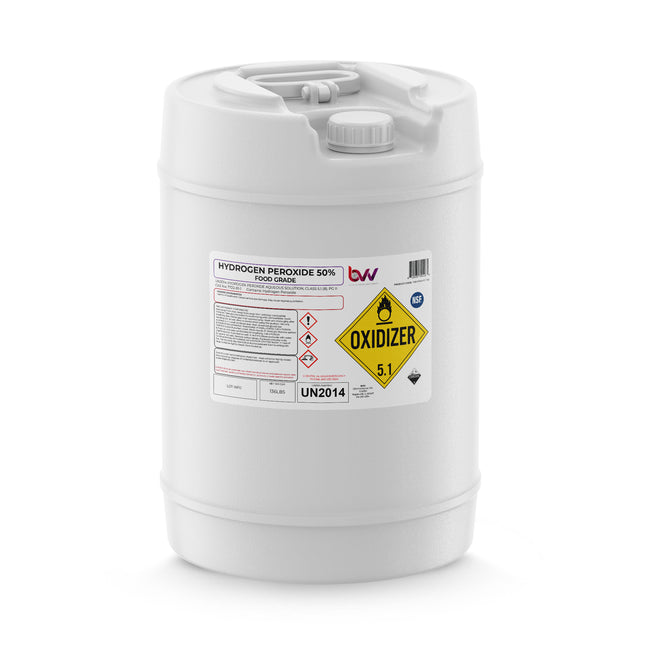

Hydrogen Peroxide 50% Food Grade
50% Food Grade Hydrogen Peroxide Our Food-grade 50% peroxide tests at ~50.4%. This the strongest peroxide we offer, next to our 35% Food Grade Peroxide, Our Food Grade 50% hydrogen peroxide is formulated with a special stabilizer package (organophosphonate) that replaces transition metals stabilizers typically found in hydrogen peroxide solutions. Our Peroxide is NSF® Certified. NSF-certified means a product was independently verified for safety, sanitation, and quality by NSF. NSF certification is recognized by health departments, government agencies, and industry associations. *Certified under ANSI/NSF Standard 60 Drinking Water Additives-Health Effects. Dosage levels shall be in accordance with NSF requirements. 55 Gallon Drum weights 548lbs, 270 Gallon Tote weighs 2500lbs. hydrogen peroxide usually loses less than 1% of its initial concentration in one year (0.5% for a 50% solution). 50% Hydrogen Peroxide NSF Food Grade Certificate of Analysis 50% Hydrogen Peroxide NSF Food Grade Safety Data Sheet Chemical Formula: H2O2 Molecular Weight: 34.015 g/mol CAS Registry Number: 7722-84-1 Appearance Colorless Liquid Odor: None Density 1.196 g/cm3 @ 20 °C (68 °F) Boiling Point: 114 °C (237 °F) Solubility in water: Completely Soluble GHS Pictograms: GHS Signal Word: Danger GHS Hazard Statements: H272, H302 + H332, H314, H335 GHS Precautionary Statements P210, P220, P260, P261, P264, P270, P271, P280, P283, P301+P317, P301+P330+P331, P302+P361+P354, P304+P340, P305+P354+P338, P306+P360, P316, P317, P321, P330, P363, P370+P378, P371+P380+P375, P405, P420, and P501 UN Identification Number: 2014 Proper Shipping Name: 50% Hydrogen Peroxide, Aqueous Solution Transport Hazard Class: 5.1, 8 Packing Group: II DOT Placard:
$360.79 - $895.05
-
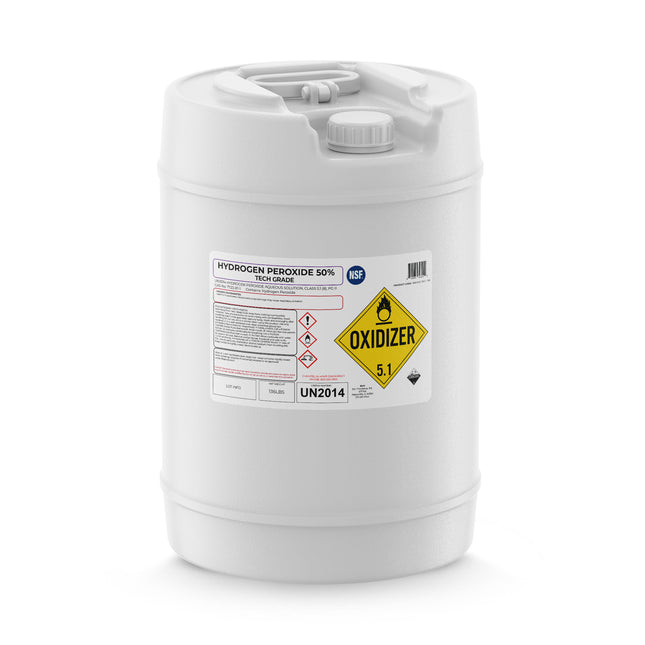

Hydrogen Peroxide 50% NSF Tech
50% Technical Grade Hydrogen Peroxide Our Technical-grade 50% peroxide tests at ~50.4%. Is the strongest proxied we offer, next to our 35% Technical Peroxide, Our Technical Grade 50% hydrogen peroxide is formulated with a special stabilizer (organophosphonate) package that replaces transition metals stabilizers typically found in hydrogen peroxide solutions. Our Peroxide is NSF® Certified. NSF-certified means a product was independently verified for safety, sanitation, and quality by NSF. NSF certification is recognized by health departments, government agencies, and industry associations. *Certified under ANSI/NSF Standard 60 Drinking Water Additives-Health Effects. Dosage levels shall be in accordance with NSF requirements. 55 Gallon Drum weights 548lbs, 270 Gallon Tote weighs 2500lbs. hydrogen peroxide usually loses less than 1% of its initial concentration in one year (0.5% for a 50% solution). 50% Hydrogen Peroxide NSF Technical Grade Certificate of Analysis 50% Hydrogen Peroxide NSF Technical Grade Safety Data Sheet Chemical Formula: H2O2 Molecular Weight: 34.015 g/mol CAS Registry Number: 7722-84-1 Appearance Colorless Liquid Odor: None Density 1.196 g/cm3 @ 20 °C (68 °F) Boiling Point: 114 °C (237 °F) Solubility in water: Completely Soluble GHS Pictograms: GHS Signal Word: Danger GHS Hazard Statements: H272, H302 + H332, H314, H335 GHS Precautionary Statements P210, P220, P260, P261, P264, P270, P271, P280, P283, P301+P317, P301+P330+P331, P302+P361+P354, P304+P340, P305+P354+P338, P306+P360, P316, P317, P321, P330, P363, P370+P378, P371+P380+P375, P405, P420, and P501 UN Identification Number: 2014 Proper Shipping Name: 50% Hydrogen Peroxide, Aqueous Solution Transport Hazard Class: 5.1, 8 Packing Group: II DOT Placard:
$333.04 - $749.34
-


Ice Water Extraction Kit
BVV's Ice Water Extraction Kit Designed with our solventless extractors in mind BVV's Ice Water Extraction Kit was engineered for durability and ease of use. Comprised of our sanitary grade seamless 55-gallon 304 stainless steel washing vessels. Our easy drain barrels come complete with 4X 1.5" Triclamp drains mounted as low as possible for effortless draining of its 55-gallon volume capacity. Perfect for medium to large-scale ice water extraction labs this kit comes complete with industry-leading Boldtbags Lock-top Full mesh stacker grading bags and a 20lb capacity Large BoldtBags Open Top Washing Bag for unbridled durability and ease of use. The ice Water Extraction Kit comes with your choice of either a low shear Multi-stage pump ideal for gravity draining or a hash-safe pneumatically driven diaphragm pump. Processing Power Material Capacity Per Batch: 20-30LB Water Capacity: 55 Gallons Cycle Time: 60-90 Minutes Daily Extraction Capacity: Up to 60 lb, per 8-hour shift Specifications 2X 23"x36" 55-gallon Stainless Steel Washing Vessel 4X 1.5" Tri-clamp ports 4X BoldtBags Lock-top Full mesh stacker grading bags (190um(Green),160um(Red),90um(Black),45um(White)) 1X Large Boltd Open Top Wash Bag (20lb Capacity) 1X Food grade PTFE mixing paddle 1X 27 GPM Low shear Multistage pump or 16 GPM hash-safe pneumatically driven diaphragm pump. 1X 25Ft 1" Clear Braided PVC Hose 1X 1.5" Tri-clamp Thermometer (0-220F/0-100C) 4X Polycarbonate Sight glasses 2X 1.5" Tri-Clamp Butterfly valves with 1" barbed fittings Performance Seamless sanitary construction Low-mounted drain ports for complete draining Tri-Clamp Thermometer for water temperature measurement Polycarbonate sight glasses for visual monitoring of the process Open Top Wash Bag for easy loading & unloading Low-shear force Multistage pump for gentle water transfer or a hash safe pneumatically driven diaphragm pump
$7,979.09 - $10,268.74
-
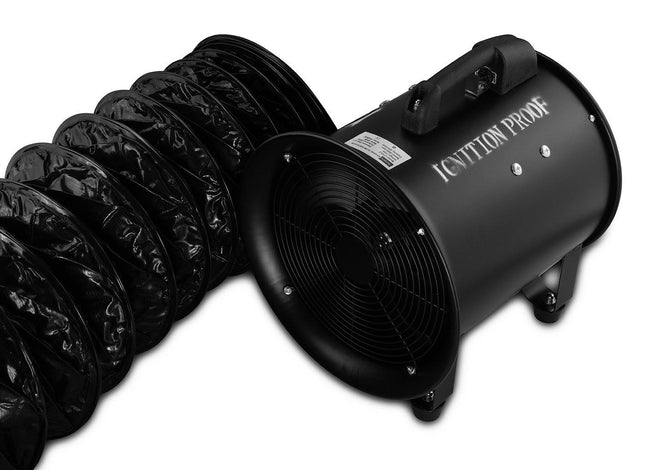

Ignition Resistant Axial Fans
Our Ignition Resistant Axial fan with 30' of ducting provides the user with much-needed air circulation within a room to move flammable gases and any other air contaminants to an area with open air. This axial fan features superior design and durable construction, ensuring long-lasting capabilities with proper maintenance. Many of these gases are heavier than air so it is best to keep the fan ground level to provide the best room circulation possible. The body is made of carbon steel and the impeller is made of aluminum. This combination provides a spark-free environment should the impeller make contact with the body. Warning: Do not run the fan daisy-chained, it will cause disruption with air circulation and may cause the fan to back up air into the room. ***Note: Do not run fans daisy-chained it will cause disruption with air circulation and may cause the fan to back up air into the room. Specifications Impeller Size: 8" 12" 16" Actual Size LxWxH: 14x9x14 15x13x18 18x17x22 Voltage: 110v/60Hz (USA Plug) RPM: 2800 2800 3300 Watts: 180w 500w 1100w Airflow CFM: 880 2300 4200 Noise: 61(AdB) 69dB(A) 79dB(A)
$72.16 - $277.53
-
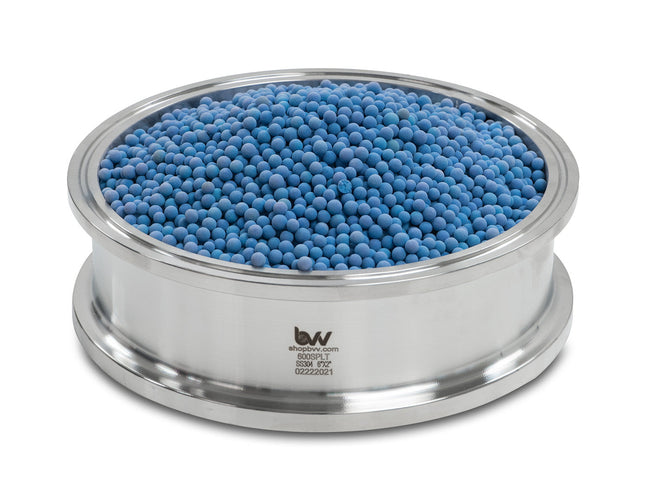

Indicating Molecular Sieve Beads Type 4A
Indicating Molecular Sieve Beads TYPE 4A (Blue) Description: 4A Blue Indicating Molecular Sieve is a porous, high capacity alkali metal aluminosilicate compound. Like non-indicating 4A molecular sieve, our blue indicating 4A molecular sieve has 4 Angstrom-sized pore openings that allow to adsorb all molecules adsorbed by 3A, molecular sieve, plus larger molecules like aromatic and branched-chain hydrocarbons. Handling & Storage Recommendations: Store in a dry location to prevent unintentional water adsorption. Reseal packages after opening to prevent contamination and unintentional water adsorption. We recommend that you rotate stock so the oldest material is used first. Please read the safety data sheet to ensure proper handling and always wear personal protection equipment when handling molecular sieve. Molecular Sieve 4A Indicating Technical Data Sheet Molecular Sieve 4A Indicating Technical Data Sheet
$22.20 - $1,352.98
-

Custom Cones USA Industrial Plant Material Grinder - Open Box Demo
Industrial Plant Material Grinder - Open Box Demo Stop blending or shredding your plant material into dust! Our Industrial Plant Material Grinder was built with your products in mind. With three screen sizes and multiple blade options, the machine will grind your plant material to the perfect consistency without destroying the valuable trichomes you worked so hard to grow! Fitting perfectly beside your cone-filling machine, our Industrial Plant Material Grinder uses a high torque, low-rpm motor to ensure your plant resins and trichomes aren't damaged due to friction and high heat. This plant material grinder comes in small, medium, and large screen sizes, allowing you to control your plant material's particle size. Whether you want a blend of particle sizes to create the perfect product or require a different screen size for different strains - the flexibility of our plant material grinder is unmatched. The industrial plant material grinder features stainless steel blades manufactured to reduce residue buildup on the blades. The blades are removable for easy access cleaning, so you never need to worry about excessive downtime cleaning your product machines. Stop turning your plant material to dust and get a plant material grinder that keeps your plant material as potent and flavorful as possible while ensuring the perfect size, all with perfect ease! Specifications OUTPUT: 1lb per minute. A continuous grinding system means no loading/downtime on the machine. MACHINE TYPE: Grinder GRINDER SCREEN SIZES: Small: 4mm diameter, Medium: 5.5mm diameter, Large: 6mm diameter. Also available for purchase: Extra Small: 3mm diameter NO MORE DUST: 3 included- Small, Medium, Large. Extra Small available separately) of adjustable screens, so you can control the particle size of your grind and safely hand over the grinding process to anyone on your team! EASY TO CLEAN: The grinder is made of stainless steel with easily removable parts for cleaning and soaking. CERTIFICATION: UL Listed WARRANTY: 1 Year Warranty Standard. Please see additional details in the FAQ. POWER REQUIREMENT: 110V. Please note that a plug adapter and step-down transformer may be needed to convert high-voltage power to a lower voltage if this machine is used outside the U.S. or Canada. SIZE: 18in x 18in x 12in Perfect Grind Our Industrial Plant Material Grinder comes with adjustable screen sizes and is fully customizable, so you can create the perfect grind for your plant material. Some strains are more dense than others, so the adjustable screens and blade configurations on this machine allow you to get the perfect grind every time - no more turning your plant material into dust! Once you have the ideal grind, we recommend completing your fleet of machines with a sifting machine and packing your cones with our King Kone filling machine! Terpene Preservation The high-torque and low RPM design of this plant material grinder helps preserve terpenes and trichomes in the plant material by reducing the amount of heat and stress applied to it. The blades of our plant material grinder move much slower compared to a high-rpm grinder like a blender or one of the whip-style plant material grinders, but this machine still has enough torque to grind dense buds with ease. Industrial Build Made of stainless steel and all food-grade materials, our Industrial Plant Material Grinder is built like a tank. The stainless steel blades are removable and easy to clean. The entire machine can be taken apart quickly and cleaned with alcohol. Plus, each Industrial Plant Material Grinder comes with a one-year Warranty, and all parts are replaceable.
$3,467.78
-

Industrial Vibrating Sifter - 16.25 x 6" (Compare to Custom Cones)
Automatic Vibrating Sifter - Industrial 16.25 x 6" This item Ships Freight - 88 lbs. Sifting your plant material is a great way to remove stems automatically, and if you are producing a premium pre-roll product, it is always best to sift out any stems! Our Large Automatic Vibrating Sifter was explicitly designed with plant processors in mind - the stainless steel construction and screens ensure you can easily clean our sifter, and the screen sizes are fine-tuned for the most common sifting needs. Once you've ground your plant material, you only need to pour your flower into the sifter and switch it on. You can now walk away and wait for your flower to be automatically sifted - no more standing around doing manual sifting. Sifting your plant material will not only ensure no stems make it into your pre-rolls but will also ensure nothing else makes it into your pre-rolls, like large leaves, gravel, or any other foreign matter. The consistent grind will make your pre-rolls burn more evenly and pack more evenly in any cone-filling machine. Package Dimensions - 19"x21"x35"
$2,081.50
-


Inland Vacuum Inland 15A Vacuum Pump Oil
Inland 15A Vacuum Pump Oil Inland 15A Vacuum Pump Oil Safety Data Sheet SDS
$20.82 - $1,935.80
-


Inland Vacuum Inland 19 ULTRA® Semi-Synthetic Vacuum Pump Oil
Inland 19 ULTRA® Semi-Synthetic Vacuum Pump Oil Disclaimer: Spigots/Faucets are only compatible with 5 Gallon Jugs and must be purchased separately Inland ULTRA® products are semi-synthetic hydrocarbon fluids designed to endure thermal and chemical stresses much better than standard vacuum pump fluids. The ultra-refined process eliminates nitrogen, sulfur, oxygen, and aromatic hydrocarbons, leaving a clear base stock virtually free of impurities. The additive package will not volatize under thermal stress; the antioxidant will stay in solution and bond up to four times as many radicals as other antioxidants, extending the life of the pump and the fluid. Inland 19 ULTRA® MSDS Properties: Good Thermal Stability Oxidation Resistant Hydrotreated Low Vapor Pressure Long Fluid Life Areas of Application: Mass Spectrometry Electron Microscopy thin Film Sputtering Vacuum Distillation and impregnation UHV Surface Analysis Vacuum Furnaces and Heat Treatment EB Welding Vacuum Tube Evacuation Vacuum Metallization Chemical Pumping Specification Inland 19 ULTRA Vapor Pressure at 25ºC (torr) <1x10-6 Boiling Point at .01 torr (ºC) 166 Viscosity at 40ºC (cSt) 55 Pour Point (ºC) -10 Flash Point (ºC) 247 Fire Point (ºC) Density at 25ºC (g/ml) 0.86 Color clear
$37.47 - $2,671.26
-
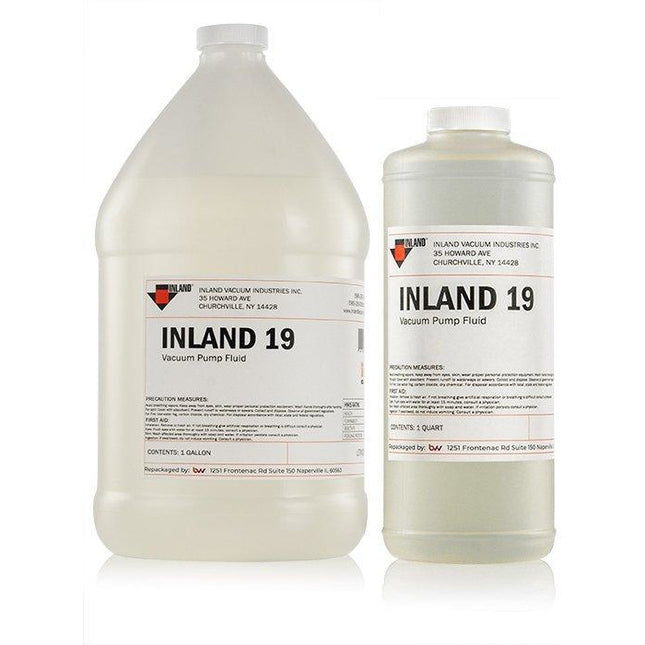

Inland Vacuum Inland 19 Vacuum Pump Oil for Edwards, Welch, Leybold, Agilent
Inland 19 Vacuum Pump Oil Inland 19 is Inland Vacuum’s recommended general-purpose hydrocarbon fluid for mechanical vacuum pumps used in non-corrosive applications. The manufacturing process of Inland 19 includes molecular distillation, which removes light end fractions present in the fluid and gives it the desired properties: lower vapor pressures, reduced backstreaming, and longer fluid life. As a result, it can be used within the same applications as more expensive diffusion pump oils which would otherwise be contaminated by a vacuum oil of lower grade.A durable, long-lasting mechanical pump fluid, Inland 19 is cost-effective in vacuum applications such as mass spectrometers, electron microscopes, thin-film sputtering, UHV systems, and freeze dry systems. Proper use of this oil effects reduced maintenance costs, improved pumping cycles, and a cleaner vacuum system. Inland 19 MSDS Properties: Molecularly distilled Reduced backstreaming Increased fluid life Low vapor pressure Areas of Application: Mass spectrometry Electron microscopy Thin film sputtering UHV systems Freeze dry systems Other non-corrosive general applications Specifications Inland 19 Vapor Pressure at 25ºC (torr) 1x10-5 Boiling Point at .01 torr (ºC) 112 Viscosity at 40ºC (cSt) 55 Pour Point (ºC) -15 Flash Point (ºC) 213 Fire Point (ºC) 244 Density at 25ºC (g/ml) 0.87
$29.14 - $1,802.58
-


Inland Vacuum Inland 56 Vacuum Pump Oil (LVO 200)
Inland 56 Vacuum Pump Oil The Inland 56 is an equivalent to the Leybold LVO 200 oil. This oil can be used in pumps specifically designed for pumps that use the Leybold LVO 200 oil. Inland 56 Vacuum Pump Oil Safety Data Sheet SDS
$31.92 - $5,293.95
-


Inland Vacuum Inland 70 Ultra Vacuum Pump Oil (Edwards Ultragrade 70)
Inland 70 Ultra Vacuum Pump Oil This is oil is a direct replacement for Edwards Ultragrade 70 oil. Specifications Inland 70 Ultra Vapor Pressure @25°C 1x10^-7 torr Viscosity @ 40°C 72 cSt Pour Point: -10°C Flash Point: 249°C Density: 0.86 g/ml Color: Clear Inland 70 Ultra Safety Data Sheet PDF
$23.59 - $2,576.20
-


Inland Vacuum Inland FF-10 Flushing Fluid
Inland FF-10 Flushing Fluid Inland FF-10 is a solvent free hydrocarbon flushing fluid designed to be used as part of a preventive maintenance program. Periodic use of FF-10 will enable the user to remove contaminants and particulates from within all areas of the pump without the worry of contaminating the pump with an expensive solvent Specifications FF-10 Vapor Pressure at 25ºC (torr) 2x10-4 Viscosity at 40ºC (cSt) 28 Viscosity at 100ºC (cSt) 4.5 Flash Point (ºC) 199 Fire Point (ºC) 221 Density at 25ºC (g/ml) 0.85 Inland FF-10 Flushing Fluid Safety Data Sheet SDS
$19.43 - $1,415.42
-
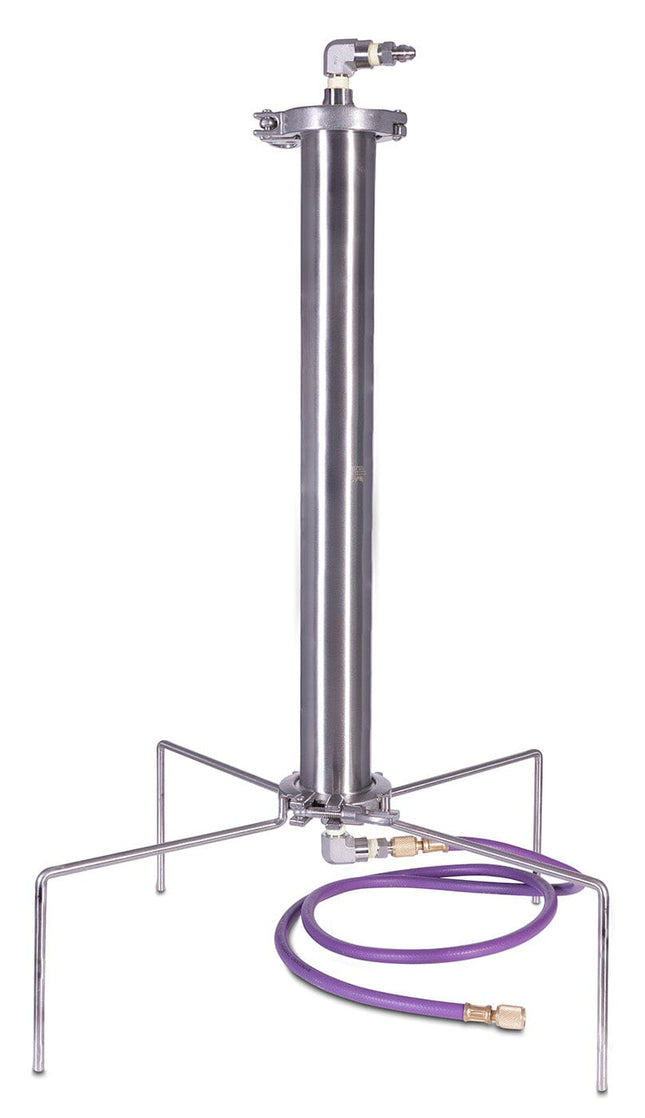

Inline Candy Desiccant Dryer
The inline candy desiccant dryer is a necessary accessory to any one using a vacuum oven for candy drying. The column will need to be filled by the user with silica gel and has fine mesh stainless filters on each end to hold in the beads. We recommend connecting the vacuum inlet from the pump to the top of the column to prevent any water accumulation in the beads from reaching the pump via gravity. The bottom of the column will connect to the oven itself. The column holds 1.5lb of silica gel desiccant. Its water holding capacity is 36%. Since 1lb of candy can hold as much as 40-60g of water, a 1lb column of desiccant will have the capacity to handle approximately 4.5-5lb of fresh candy drying before it needs to be reactivated. Silica gel can be reactivated by placing in an oven on a sheet pan for 0.5-2.0 hours at 200-250F or microwave for 10 minutes on defrost. BVV Hook Up Guide - Quick Assembly PDF Size Variants Standard Size 2" Outside Diameter x 24" Tall Column (Holds 1.5lbs Silica) XL Size Column 3" Outside Diameter x 36" Tall Column (Hold 6.5lbs Silica) Extension Kit for the Standard Column 2" Outside Diameter x 24" Tall (Holds1.5lbs Silica) *Silica Gel: Source from amazon (USE Clear silica gel) https://www.amazon.com/Dry-Quart-White-Silica-Desiccant/dp/B014VM4AZI/ref=sr_1_3?crid=N1FARCPRUFPT&keywords=silica+gel+clear&qid=1678139406&sprefix=silica+gel+cle%2Caps%2C100&sr=8-3
$97.14 - $441.28
-
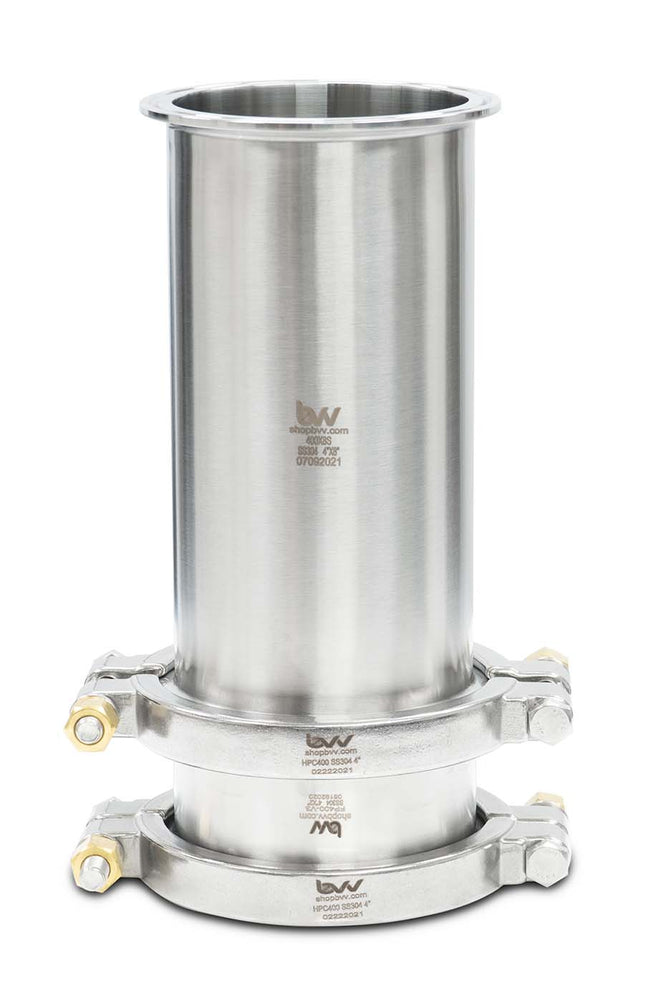

Inline CRC
Inline CRC Kit BVV's Inline CRC Kit can be utilized to adapt any 1.5", 2", 3", 4", or 6" diameter material column for inline adsorbent filtration. This kit includes a corresponding sized media column and a filter stack including a 5 micron & 1 micron Dutch Weave Sintered Filter Disc. This Inline color remediation kit is meant to be plumbed between your existing extractors material column and the existing hemispherical reducer of any closed loop hydrocarbon extractor.Assembly starts with placing the 1 micron sintered disk and gasket between the extracts hemispherical reducer and the included filter plate securing both with one of the included high-pressure clamps. Next, take the 5-micron sintered disk and the included ashless filter paper and rip around the circumference of the sintered disk, placing both atop the filter plate placing the sintered disc gasket and media column spool over top before securing both with the remaining high-pressure clamp. Since the spool secures the filter paper in place a filter plate ring is not required. Media can then be layered into the media column by weight before placing the loaded material column above the adsorbent filtration column and assembling the remainder of the extractor. For optimum filtering results utilize the following layer recipe from top to bottom: 30-50g per lb of biomass Silica 60A 75-100g per lb of biomass Bentonite Clay 30-50g per lb of biomass Neutral Activated Alumina This Kit includes: Media column Tri-clamp Spool V3 Filter Plate 5 Micron Sintered Disk 1 Micron Sintered Disk 2X Buna-N Sintered Disc Gaskets 2X High-pressure Clamps Fast Flow Ashless Filter Paper (100qty) *This video provides a visual assembly of the 3" Inline CRC which is applicable across all sizes*
$333.04 - $971.37
-
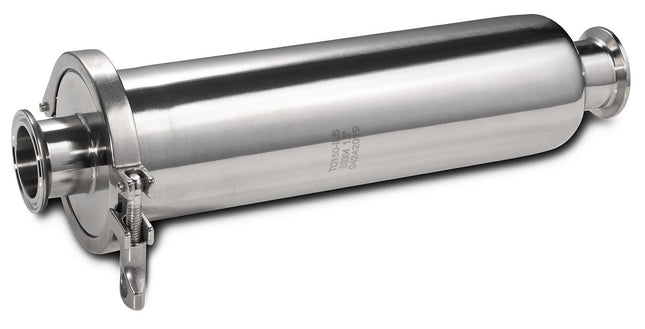

Inline Strainer 304 Stainless Steel
Inline Strainer 304 Stainless Steel Inline Tri-Clamp strainers are used when filtering solids from liquids in fluid processing systems. The inside of the strainer is perforated with 2mm holes to collect larger solids when filtering and comes with (1) 3" Single pin clamp and (1) 3" silicone Tri-Clamp gasket. It is recommended that a strainer be placed after a pump, as the suction could damage the strainer core. Specifications Material 304 Stainless Steel Connection Type 1.5" Tri-Clamp Secondary Mesh Perforated Stainless Steel with 2mm Holes
$270.60
-
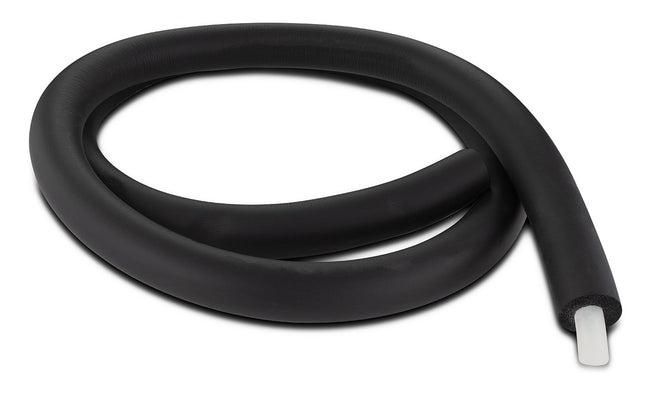

Insulated Heavy Duty 1/8" Wall Silicone Tubing For Flow - 6 Feet
Insulated Heavy Duty 1/8" Wall Silicone Tubing For Flow - 6 Feet (**Note: This tubing is only for flow and is NOT vacuum rated) The most outstanding properties of SILCON tubing are its flexibility and resistance to temperature extremes. These, plus its good electrical properties and ability to self-extinguish, make SILCON tubing an excellent choice for appliances and computers Peroxide-cured SILCON contains no sulfur or other acid-producing chemicals, thereby eliminating the possibility of staining, corroding, or deteriorating materials it contacts. It is extremely resistant to ozone and U.V. over long time periods. Care is recommended in the selection of fittings and clamps for SILCON as sharply barbed fittings or unlined metal clamps could tear into the tubing wall and possibly cause a failure. SILCON may be low-pressure steam sterilized in-line or autoclaved at up to 250°F in a normal autoclaving cycle. However, if exposed to repeated steam sterilization or long-term high temperature or pressure, silicone will eventually relax and become gummy. It should then be replaced. Insulation Compliance: ASTM C 534, Type I – Grade 1 ASTM D 1056, 2C1 ASTM E 84, UL723 ASTM G21/C1338 CAN/ULC S102 ➀ City of New York Approval MEA 107-89M MIL-P-15280J, FORM T ➁ NFPA 90A, 90B UL 181 UL 94 5V-A, V-0, File E55798 Insulation Approvals, Certifications, Compliances: 3rd party certified by FM Approvals through 1-1/2" wall thickness per FM 4924 GREENGUARD® Children & Schools Indoor Air Quality certified. Manufactured without CFCs, HFCs, HCFCs, PBDEs, or Formaldehyde. Made with EPA registered Microban® antimicrobial product protection. All Armacell facilities in North America are ISO 9001:2008 certified. Plenum Rated Conforms to ASHRAE 90.1 Energy Standards Conforms to building codes: International Mechanical Code, IMC, International Energy Conservation Code, IECC, International Residential Code, IRC, Title 24California Building Energy Efficiency Standards. Please call or email Best Value Vacs to request different sizes and thickness (1/16" to 3/4"ID) - Colors for industrial applications are available through minimum order. Key Features: Made from FDA-sanctioned ingredients Insulation R-Value of 3.3 Able to resist extreme temperature variation: -100°F to 500°F Translucent natural color for visual contact with the flow resilient, stretchable, and resistance to compression set Odorless, tasteless and inert Good electrical and weatherability properties - resists U.V., ozone, gases, and moisture Certified by the National Sanitation Foundation (NSF-51) for food equipment materials MADE IN THE U.S.A. Specifications/Physical Properties Hardness, Shor A +/-5 50 Tensile Strength, PSI 1100 Elongation at Break % 375 Brittle Temperature °F -100 Max Operating Temperature °F 500 Max Operating Temperature for NSF °F 350 Comp. Set 22 Hrs. at 177°F, % 35 Tear Resistance (PPI minimum) 100 Tubing Specifications Chart ID (IN.) OD (IN.) STANDARD LENGTH WORKING PSI @ 70°F BURST PSI @ 70°F LBS PER 100FT 1/16 1/8 100 10 30 0.50 1/16 3/16 100 20 60 1.34 3/32 5/32 100 10 30 0.66 3/32 7/32 100 15 45 1.58 1/8 3/16 100 10 30 0.88 1/8 1/4 100 20 60 2.00 1/8 5/16 100 25 75 3.32 1/8 3/8 100 28 84 4.92 5/32 9/32 100 20 60 2.14 5/32 11/32 100 20 60 3.64 3/16 1/4 100 5 15 1.22 3/16 5/16 100 20 60 2.64 3/16 3/8 100 20 60 4.12 3/16 7/16 100 15 45 6.14 1/4 5/16 100 10 30 1.50 1/4 3/8 100 5 15 3.34 1/4 7/16 100 20 60 5.12 1/4 1/2 100 15 45 7.50 5/16 7/16 100 10 30 3.66 5/16 1/2 100 10 30 6.30 3/8 1/2 100 10 30 4.32 3/8 9/16 100 10 30 7.15 3/8 5/8 100 10 30 10.16 3/8 3/4 100 15 45 16.72 7/16 5/8 100 10 30 7.70 1/2 5/8 100 5 15 5.84 1/2 11/16 100 5 15 9.50 1/2 3/4 100 10 30 13.12 1/2 7/8 100 10 30 15.00 5/8 3/4 100 5 15 6.86 5/8 13/16 100 5 15 11.34 5/8 7/8 100 5 15 13.38 5/8 1 100 10 30 22.86 3/4 1 50 5 15 17.64 3/4 1-1/8 50 10 30 26.56
$97.14
-


Insulation Jackets for Centrifuges
Insulation Jackets for Centrifuges ***Disclaimer: Fiberglass may be present on the exterior of the jacket and users should use PPE when handling the jacket. These insulated jackets are specifically designed to fit BVV brand Centrifuges and allow the user to better control and keep a more stable temperature when running the system. The jackets are made out of flame retarded material and are insulated with fiberglass.
$624.45 - $1,595.82
-


Isopropyl Alcohol 70% Tech Grade
Isopropyl Alcohol 70% Technical Grade Isopropyl alcohol is a fast-evaporating solvent and industrial cleaning agent, intended for industrial or professional use only. It can be used as a solvent for gums, shellac, and essential oils. Can be used as a fuel additive. Isopropyl Alcohol (liquid) - 70% Purity / 30% De-Ionized Water Shelf Life - 5 years Chemical Formula: C3H8O Molecular Weight: 60.096 g/mol CAS Registry Number: 67-63-0 Appearance Colorless Liquid Odor: Pungent Alcoholic odor Density 0.858 g/cm3 @ 20 - 25 °C (68 - 77 °F) Boiling Point: 80.9 - 83.2 °C (177.6 - 181.8 °F) Solubility in water: Completely Soluble GHS Pictograms: GHS Signal Word: Danger GHS Hazard Statements: H225, H319, H336 GHS Precautionary Statements P210, P233, P240, P241, P242, P243, P261, P264+P265, P271, P280, P303+P361+P353, P304+P340, P305+P351+P338, P319, P337+P317, P370+P378, P403+P233, P403+P235, P405, and P501 UN Identification Number: 1219 Proper Shipping Name: Isopropanol Transport Hazard Class: 3 Packing Group: II DOT Placard: Isopropyl Alcohol 70% Tech Safety Data Sheet (SDS) Isopropyl Alcohol 70% Tech Certificate of Analysis (COA)
$19.43 - $3,261.02
-


Isopropyl Alcohol 70% USP
Isopropyl Alcohol 70% USP Isopropyl alcohol is a fast-evaporating solvent and industrial cleaning agent, intended for industrial or professional use only. It can be used as a solvent for gums, shellac, and essential oils. Can be used as a fuel additive. Isopropyl Alcohol (liquid) - 70% Purity / 30% De-Ionized Water Shelf Life - 5 years *Disclaimer: 1 Quart Bottles are exempt from additional Hazmat shipping charges and can ship immediately, Less paperwork for shipping is required for shipping only 1 single bottle per order. Chemical Formula: C3H8O Molecular Weight: 60.096 g/mol CAS Registry Number: 67-63-0 Appearance Colorless Liquid Odor: Pungent Alcoholic odor Density 0.786 g/cm3 (20 °C) Boiling Point: 82.6 °C /180.7 °F Solubility in water: miscible GHS Pictograms: GHS Signal Word: Danger GHS Hazard Statements: H225, H302, H319, H336 GHS Precautionary Statements P210, P261, P305+P351+P338 UN Identification Number: 1219 Proper Shipping Name: Isopropanol Transport Hazard Class: 3 Packing Group: II DOT Placard: Isopropyl Alcohol 70% Safety Data Sheet (SDS) Isopropyl Alcohol 70% Certificate of Analysis (COA)
$22.20 - $3,399.79
-


Isopropyl Alcohol 99% Tech Grade
Isopropyl Alcohol IPA 99% Isopropyl alcohol, also known as 2-propanol or rubbing alcohol, is one of the most common alcohol solutions. The exact mechanism behind isopropanol’s disinfectant is not certain, however, it’s believed to kill cells through the process of denaturing cell proteins and DNA, dissolving cell lipoprotein membranes, and obstructing cellular metabolism. Isopropanol has a range of applications and uses across multiple industries, from medicine to cosmetics, and we explore this below. Cleaning Agent for Extraction, Laboratory, and Medical Industries In addition, 99% pure isopropyl alcohol serves as a cleaning agent for the laboratory, medical, and extraction industries. Mixed with water, this solution can be used as a rubbing-alcohol antiseptic. Quality solvents are vital for cleaning delicate electronics, extraction equipment, and other sensitive items. It also makes a perfect solution for surface disinfectant. 99% IPA evaporates cleanly and minimizes residual substances. Cleaning Agent for Home Care A truly versatile solution used in a variety of applications, isopropyl can also serve as a home cleaning remedy. For example, many window and toilet bowl cleaners contain isopropyl alcohol. rubbing alcohol can dissolve icky residues such as chewing gum, sap, hairspray, and other difficult compounds from hands, surfaces, and more. Other ways isopropyl can be used: Cleaning makeup brushes Cleaning blinds Cleaning sinks and chrome Deodorizing shoes Disinfecting computer mouse and keyboard Disinfecting mobile phone Dissolving windshield frost Getting rid of fruit flies Cleaning jewelry Creating homemade sanitizer Preventing ring around the collar Cleaning stainless steel Other Things to Note Spigots/Faucets are only compatible with 5 Gallon Jugs and must be purchased separately Isopropyl alcohol is a fast-evaporating solvent and industrial cleaning agent, intended for industrial or professional use only. It can be used as a solvent for gums, shellac, and essential oils. Can be used as a fuel additive. Isopropyl Alcohol (liquid) - 99.8% Purity Shelf Life - 5 years Specific Gravity - 0.79 Vapor Pressure - 1psi @ 20°C Flash Point - 12°C *Disclaimer: 1 Quart Bottles are exempt from additional Hazmat shipping charges and can ship immediately, Less paperwork for shipping is required for shipping only 1 single bottle per order. Chemical Formula: C3H8O Molecular Weight: 60.096 g/mol CAS Registry Number: 67-63-0 Appearance Colorless Liquid Odor: Pungent Alcoholic odor Density 0.786 g/cm3 (20 °C) Boiling Point: 82.6 °C /180.7 °F Solubility in water: miscible GHS Pictograms: GHS Signal Word: Danger GHS Hazard Statements: H225, H302, H319, H336 GHS Precautionary Statements P210, P261, P305+P351+P338 UN Identification Number: 1219 Proper Shipping Name: Isopropanol Transport Hazard Class: 3 Packing Group: II DOT Placard: Isopropyl Alcohol Safety Data Sheet (SDS) Isopropyl Alcohol Certificate of Analysis (COA)
$23.59 - $3,954.85
-
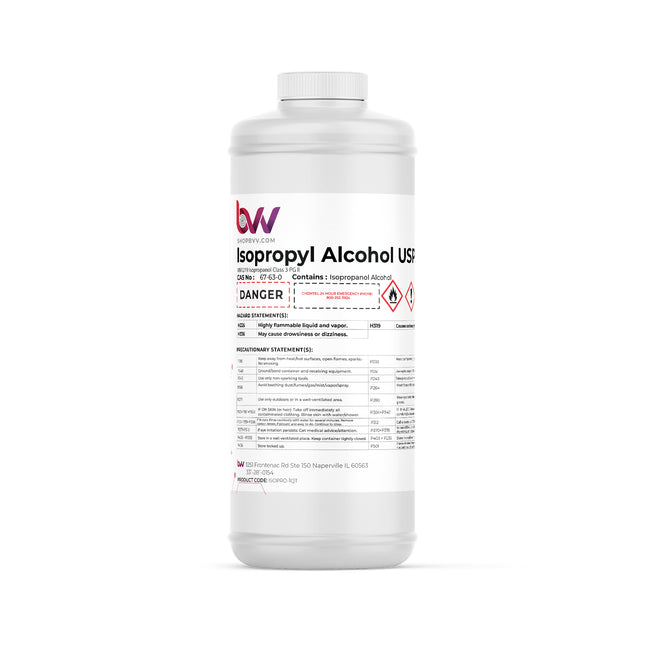

Isopropyl Alcohol 99% USP
Isopropyl Alcohol 99% USP Isopropyl alcohol, also known as 2-propanol or rubbing alcohol, is one of the most common alcohol solutions. The exact mechanism behind isopropanol’s disinfectant is not certain, however, it’s believed to kill cells through the process of denaturing cell proteins and DNA, dissolving cell lipoprotein membranes, and obstructing cellular metabolism. Isopropanol has a range of applications and uses across multiple industries, from medicine to cosmetics, and we explore this below. Cleaning Agent for Extraction, Laboratory, and Medical Industries In addition, 99% pure isopropyl alcohol serves as a cleaning agent for the laboratory, medical, and extraction industries. Mixed with water, this solution can be used as a rubbing-alcohol antiseptic. Quality solvents are vital for cleaning delicate electronics, extraction equipment, and other sensitive items. It also makes a perfect solution for surface disinfectant. 99% IPA evaporates cleanly and minimizes residual substances. Cleaning Agent for Home Care A truly versatile solution used in a variety of applications, isopropyl can also serve as a home cleaning remedy. For example, many window and toilet bowl cleaners contain isopropyl alcohol. rubbing alcohol can dissolve icky residues such as chewing gum, sap, hairspray, and other difficult compounds from hands, surfaces, and more. Other ways isopropyl can be used: Cleaning makeup brushes Cleaning blinds Cleaning sinks and chrome Deodorizing shoes Disinfecting computer mouse and keyboard Disinfecting mobile phone Dissolving windshield frost Getting rid of fruit flies Cleaning jewelry Creating homemade sanitizer Preventing ring around the collar Cleaning stainless steel Other Things to Note Spigots/Faucets are only compatible with 5 Gallon Jugs and must be purchased separately Isopropyl alcohol is a fast-evaporating solvent and industrial cleaning agent, intended for industrial or professional use only. It can be used as a solvent for gums, shellac, and essential oils. Can be used as a fuel additive. Isopropyl Alcohol (liquid) - 99.8% Purity Shelf Life - 5 years Specific Gravity - 0.79 Vapor Pressure - 1psi @ 20°C Flash Point - 12°C Boiling Point - 82°C *Disclaimer: 1 Quart Bottles are exempt from additional Hazmat shipping charges and can ship immediately, Less paperwork for shipping is required for shipping only 1 single bottle per order. Chemical Formula: C3H8O Molecular Weight: 60.096 g/mol CAS Registry Number: 67-63-0 Appearance Colorless Liquid Odor: Pungent Alcoholic odor Density 0.786 g/cm3 (20 °C) Boiling Point: 82.6 °C /180.7 °F Solubility in water: miscible GHS Pictograms: GHS Signal Word: Danger GHS Hazard Statements: H225, H302, H319, H336 GHS Precautionary Statements P210, P261, P305+P351+P338 UN Identification Number: 1219 Proper Shipping Name: Isopropanol Transport Hazard Class: 3 Packing Group: II DOT Placard: Isopropyl Alcohol Safety Data Sheet (SDS) Isopropyl Alcohol Certificate of Analysis (COA)
$24.98 - $4,405.84
-
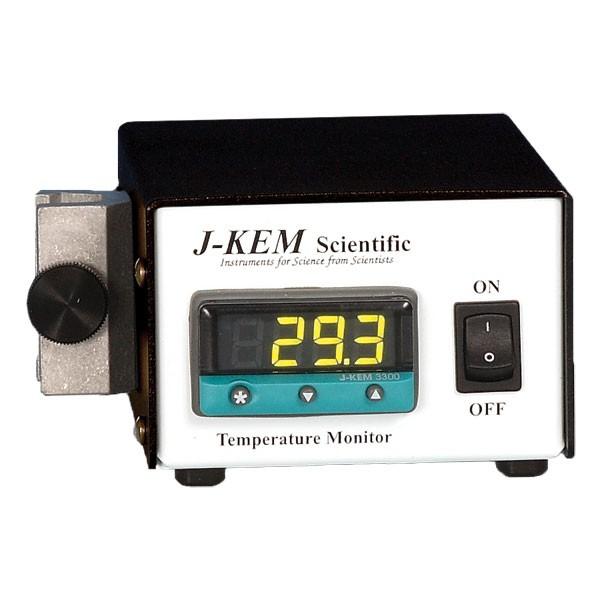
J-KEM Scientific J-KEM Digital Temperature Monitor
J-KEM Digital Temperature Monitor Monitors and displays the temperature of an attached piece of equipment on a bright LED display. Built-in USB and free KEM-Net software provide remote temperature monitoring and data logging to a GLP/GMP compliant file. Audible alarm. Specifications: 120 or 230Vac, 50 watts.Warranty: 2 Years The temperature range desired determines the probe/thermocouple type: J [black] (0 – 800° C) K [yellow] (-50 – 1200° C) T [blue] (-200 – 250° C)
$832.60
-
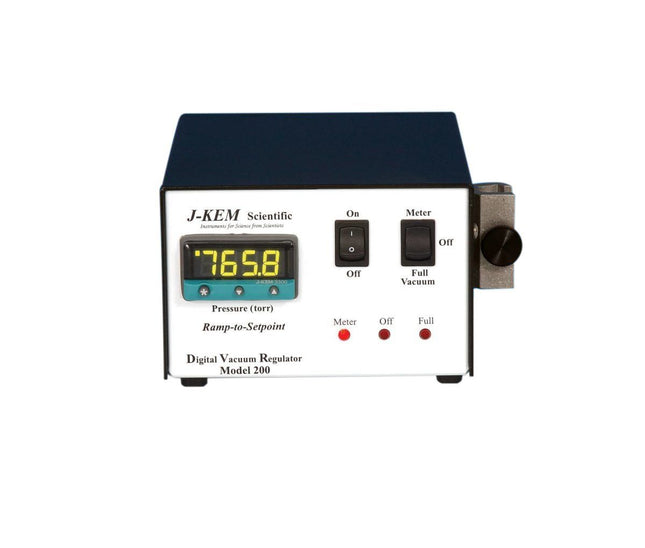
J-KEM Scientific J-KEM DVM-100
J-kem DVM-100 The DVM-100 continuously displays the pressure in a connected piece of equipment on a large digital display. The vapor path of the DVM-100 is 100% stainles steel to provide long life and chemical compatibility. Comes with J-KEM’s KEM-Net software to provide data logging and a real time graphical display of system pressure. The DVM-100 provides vacuum monitoring but not vacuum regulation.
$1,831.72
-
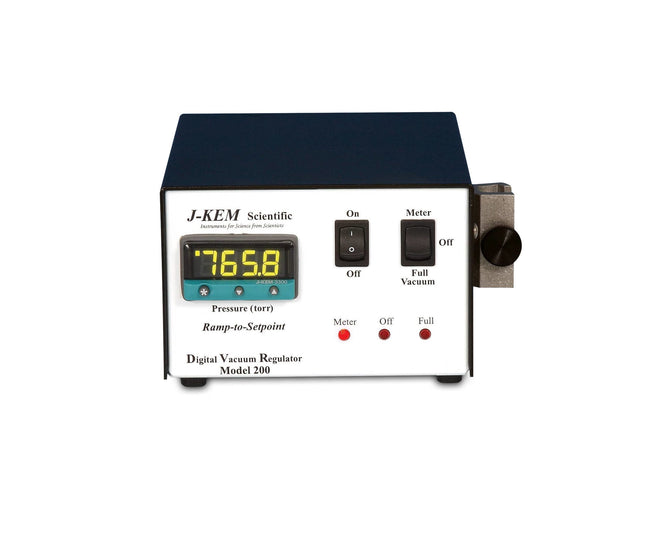
J-KEM Scientific J-KEM DVR-200-EV Digital Vacuum Regulator
J-KEM DVR-200-EV Digital Vacuum Regulator The DVR-200-EV has the same stainless steel pressure transducer inside, but the vacuum valve is outside of the controller. The value of this design is that the vacuum valve can be cleaned or replaced much easier than the valve in the classic DVR-200. Some applications, like distillations or stripping large volumes of solvent, can leave residues inside the valve which causes it to fail. Replacing the vacuum valve is the most frequent repair that J-KEM performs on the DVR-200. Replacing the valve in the classic DVR-200 is difficult and must be returned to J-KEM for repair. With the EV version, the user can disassembled the valve and wash it out, or even replace it in under 5 minutes. For large distillations or botanical applications, J-KEM recommends the DVR-200-EV. No Mercury 100% digital pressure entry and control Wetted parts are 100% stainless steel and Teflon Vacuum ramping feature eliminates bumping Resists: All organic solvents Acids Bases Water Specifications: 100 watts. Vacuum fittings: 1/8″ NPTM. Warranty: Electronics 2 Years, Vacuum Valve 6 months (void if damaged by chemical buildup)
$2,310.47
-

J-KEM Scientific J-Kem Gemini-2 Dual Temperature Controller
J-Kem Gemini-2 Dual Temperature Controller Gemini-2 Dual Temperature Controller displays two temperature controllers in a single cabinet to regulate two independent reactions. Each channel is 1200 Watts MAX (1800 Watts total), 15 Amps @ 120VAC, The Gemini is one of J-KEM’s most versatile controllers featuring high power outlets and a 100 hour digital timer (on channel 1) to turn heating OFF (or ON) at a user entered time. Features Included: Over-temperature protection circuits with audible alarms, dual temperature displays, selectable operating modes, double fused, and 100% solid state design. The USB port on the back panel of the controller is an interface to J-KEM’s KEM-Net software. Safety features include: 100% solid state, double fused, audible error alarm, and over temperature circuitry that disconnects power if an over temperature condition occurs. Specifications: Dimensions: 3.5" H x 7.75" W x 8.75" D Power: 15 Amps @ 120VAC, 1200 Watts MAX/Channel, 1800 Watts (Total) Weight: 7 lbs Complete System Includes: One controller Two Teflon thermocouples (12″ long, 1/8″ diameter) Two connecting cords Two 14/20 joint adapters
$2,177.25 - $2,665.71
-
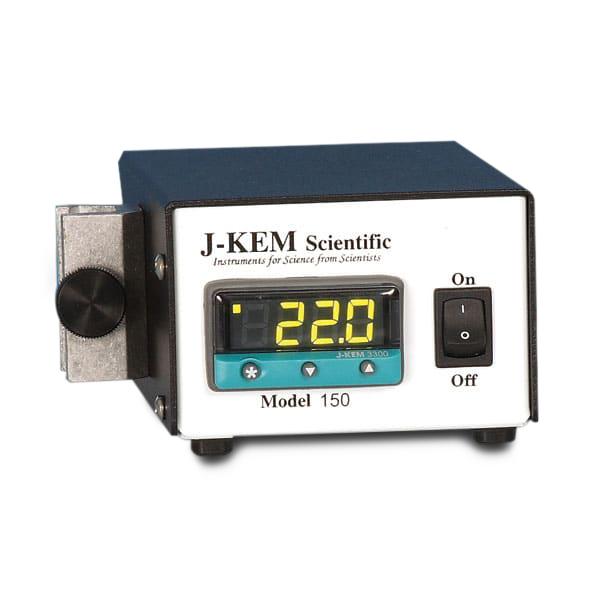
J-KEM Scientific J-KEM Model 150
J-KEM Model 150 An ideal controller for applications that don’t require the precise regulation of J-KEM’s 200-Series controllers. This compact unit packs 1200 watts of power, sufficient for 5 L heating mantles, many ovens, and other devices. Built with J-KEM’s state-of-the-art PID process controller, but does not contain J-KEM’s power control computer. Specifications: 120vac, 10 amps, 1200 wattsWarranty: 2 Years The temperature range desired determines the probe/thermocouple type: J [black] (0 – 800° C) K [yellow] (-50 – 1200° C) T [blue] (-200 – 250° C) Weight: 4 Dimensions: 5.4 x 3.75 x 2.5 in PURCHASE WITH OR WITHOUT SYSTEM ACCESSORIES Complete system includes: one controller, one Teflon thermocouple (12″ long, 1/8″ diameter), one connecting cord, and one 14/20 joint adapter.
$1,046.30 - $1,204.50
-
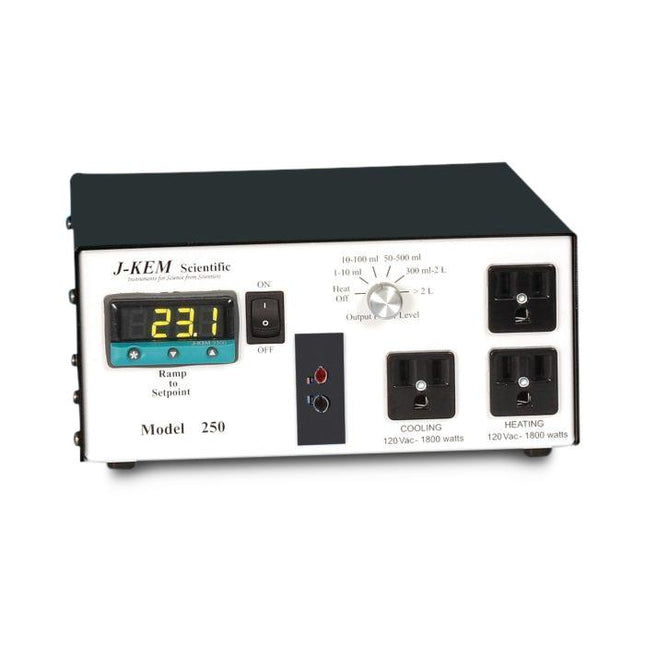
J-KEM Scientific J-KEM Model 250
J-KEM Model 250 The Model 250 has both heating and cooling outlets for maximum versatility. Two heating outlets supply 1800 watts of power for large equipment and heating mantles up to 22L. The third outlet (1800 watts), normally used for cooling, is programmable to supply power below, above, or at the set point. Contains J-KEM’s patented power control computer which provides 0.1° regulation of anything. Specifications: 120vac, 15 amps, 1800 wattsWarranty: 2 Years The temperature range desired determines the probe/thermocouple type: J [black] (0 – 800° C)K [yellow] (-50 – 1200° C)T [blue] (-200 – 250° C)RTD: (-200 – 400° C)
$1,710.99 - $1,980.20
-
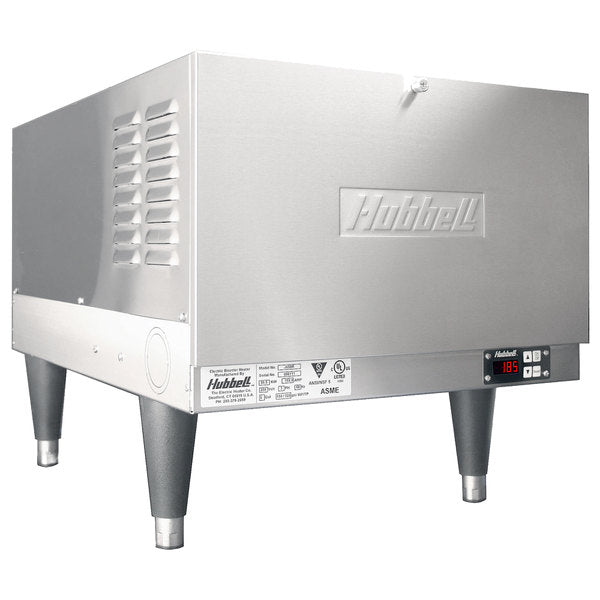

J636T Hubbell Process Water Heater 240V 3P with Pump
Hubbell Process Water Heater 240V 3P Process Water Heater 6 Gallon Stainless Steel ASME Vessel 36 kW, 240 volt, 3 phase Complete with electrical operating controls including the following: magnetic contactor, immersion elements, digital temperature controller with safety hi-temperature cut out, low water cut out, and an ASME rated combination temperature and pressure relief valve. Unit is factory assembled, insulated, jacketed, wired, and tested. Unit is ready for electrical and plumbing service connections. This kit includes a stainless steel pump to continuously circulate water through a closed loop system, an expansion chamber may be needed. Professional installation of water lines by a certified plumber is recommended. Water Heater Features Industrial Grade Construction Stainless steel pressure vessel provides maximum service life ASME Section VIII stamped vessel ensures high quality construction Heavy duty construction withstands demanding industrial use Packaged with all electrical operating controls for efficient installation Small reserve capacity lowers peak power demand and reduces operating costs in systems with ON / OFF cyclical demand Hubbell V636T Heater Specs Model J636T Voltage 240V Current Draw (A) 87 Heating Wattage (kW) 36 Storage Capacity (Gal) 6 Inlet / Outlet Connections 3/4" MNPT Circulation Pump Specs Model AHWS-25-60-180 Material Stainless Steel Power 40 W Max Head (Ft.) 18 Max Flow (GPM) 15.8 Max Water Temp (°C) 110 Voltage 220VAC / 1ph Current Draw (A) .2 Max Ambient Temp (°C) 40
$7,770.94
-


Jacketed Collection Column (6in Tri clamps)
This column can be used as a collection or solvent vessel for a larger rack mounted extractor. The top and bottom tri clamp size are 6" to allow for a higher pressure rating on the entire vessel. The jacket of the vessel is baffled and has 1/2" NPT ports to run fluid through for good temperature control. This column is intended to hold 55lbs of hydrocarbon solvent, it can be rack mounted with 12" pipe hangers. Max Pressure: 300psi @70°F (dependent on clamp used) Material: 304 Stainless Steel Capacity: 55 Liters Height: 48"
$2,497.80
-


Jacketed Collection Spool
8"x 52" Jacketed Collection Spool This spool is 8" in diameter x 52" in length with 4" Tri-Clamp ports on either end. The top has 1/4" and 1/2" NPT ports to add a gauge and pressure relief directly to the vessel. The spool has a closed jacket with 1/2" NPT ports that make this spool ideal to use as a collection tank on a rack-mounted system.
$1,526.43 $971.37
-
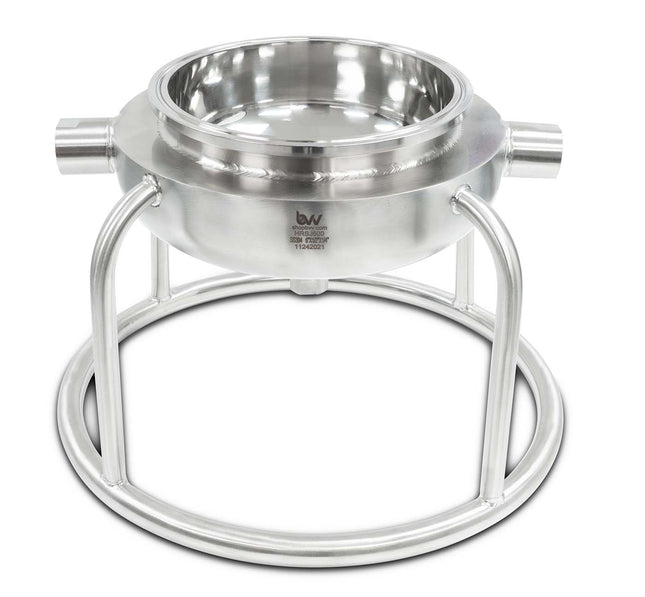

Jacketed Hemispherical Reducer Stand
Jacketed Hemispherical Tri-Clamp Reducer with Welded Ring Stand Jacketed Hemispherical Tri-Clamp Reducer with Welded Ring Stand allows the user to create a larger drain/filtering system allowing more weight to be supported with the ring stand. These reducers have (2) 1/2" FNPT connection jacket ports with Tri-Clamp connection on the top and a 1/4" FNPT drain port on the bottom. The outer jacket allows the user to recover faster or keep materials at a specific temperature for more accurate processes. Specifications: Material: 304 Stainless Steel High Polish Interior Standard: 3A Connection Types: Tri-Clamp x (2) 1/2" FNPT x 1/4" FNPT
$208.15 - $416.30
-
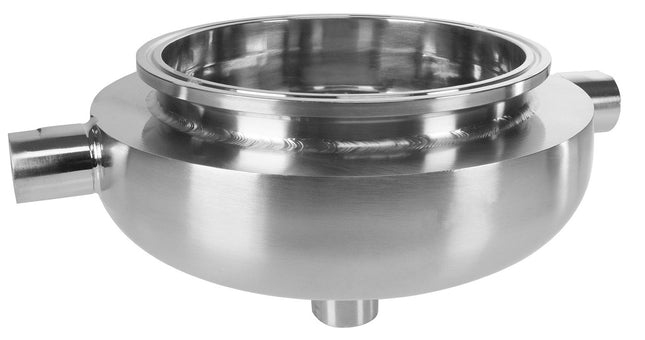

Jacketed Hemispherical Reducers with 1/2" FNPT Drain Port
Jacketed Hemispherical Reducers Jacketed Hemispherical Reducers allow the user to circulate water around the bowl and keep extracted material liquefied for easier flow through the bottom port. These jacketed reducers have 1/2" FNPT ports on either side and a 1/2" FNPT port through the bottom of the dish. These reducers are made out of 304 stainless steel with a high polish interior. Specifications Material 304 Stainless Steel Connection Type(s): Tri-Clamp 1/2" FNPT Sizes Available: 6" 10" 12"
$353.86 - $444.05
You have seen 960 out of 1655 products













































































